THE AIRPORTS
SOUTHERN CALIFORNIA
LOS ANGELES
LAX
1970s

|
February 1970 Overseas National Airways (ONA) was a supplemental air carrier that was founded in 1950 and based at New York Idlewild Airport. ONA focused its efforts on both passenger and freight charters, with a majority of flights for carrying US military personnel between the US East Coast and Europe. The airline operated a variety of aircraft including the Douglas DC-7, Douglas DC-8, and Douglas DC-10. Rolling out on Runway 25 Left during a early evening rain shower is N864F, a Douglas DC-8-63CF, delivered new to ONA in April 1969. |
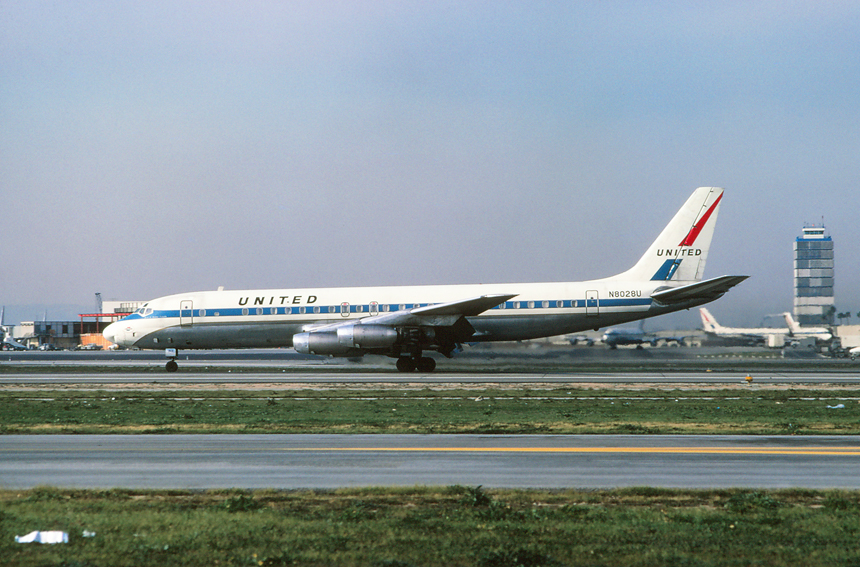
| March
1970 The Douglas DC-8 would become the backbone of the United medium, to long range fleet well into the 1970s. Flights from Los Angeles saw the DC-8 scheduled to Honolulu, Hilo, San Diego, Denver, and Chicago. Seen rolling out on Runway 25 Left after an early evening arrival is N8028U "Mainliner Waipahu," a Douglas DC-8-21, delivered new to United Airlines on June 8, 1960. |

| March 1970
By 1970, Western Airlines was utilizing their "baby-Boeing" on most of the airlines regional routes from los Angeles including service to Las Vegas, Phoenix, Sacramento, San Diego, and San Francisco. Seen unloading passengers on the ramp at Satellite Terminal 5 during a hazy spring afternoon is N4523W, a Boeing 737-247, delivered new to Western Airlines in March 1969. |

|
March 1970 Probably one of the most stylish and famous executive jets around was the famed Douglas DC-9 of Playboy Magazine publisher Hugh Hefner. Hefner placed an order for a custom Douglas DC-9-30 series plane in 1967, at a cost of $4.5 million. The plane had a very custom interior including sofa style seating (which could sleep twelve on over-night flights) and stand-up lounge. At the rear of the plane was located Hefner's private bedroom complete with a plush, elliptical bed, shower, and restroom facilities and a modern (1960s) sound and television system. Douglas also fitted the aircraft with extra fuel tanks which actually gave the DC-9 trans-Atlantic range and had forward integral air-stairs for ease of boarding. The plane was delivered in February 1969, and the all-black finish and trademark bunny logo on the tail was a quick hit. When the Playboy Corporation hit financial difficulties in the mid-1970s, Hefner decided to sell the airplane in March 1976. The airframe was eventually converted and put into passenger service with Aeromexico. Parked at the south executive ramp and showing off its unique paint "Black Bunny" scheme is N950PB, a Douglas DC-9-32, delivered new to Playboy in 1969. |

|
May 1970 Saturn Airways was started 1948, as a "supplemental" carrier providing cargo and passenger charters from a base at Oakland, California. The airline transitioned from piston engine aircraft, to its first jet aircraft the Douglas DC-8-61CF (Convertible Freighter) in December 1967. The airline eventually operated five DC-8s, including the smaller series -55 on world-wide charter service including many flights to support military efforts in Vietnam. Saturn Airways was merged into competitor Trans International Airways in December 1976. Caught during its takeoff roll on Runway 25 Left is N8008F, a Douglas DC-8-54CF, originally delivered to Trans International Airways in April 1963, then leased to Saturn in October 1968. |

| June 1970 Northwest Airlines started service into Los Angeles on October 4,1969 with flights to both Minneapolis-St. Paul and Honolulu using the Boeing 707. Seen taxiing toward the gate at Satellite 4 after an early evening arrival is N355US, a Boeing 707-351B, delivered new to the airline on October 13, 1963. |
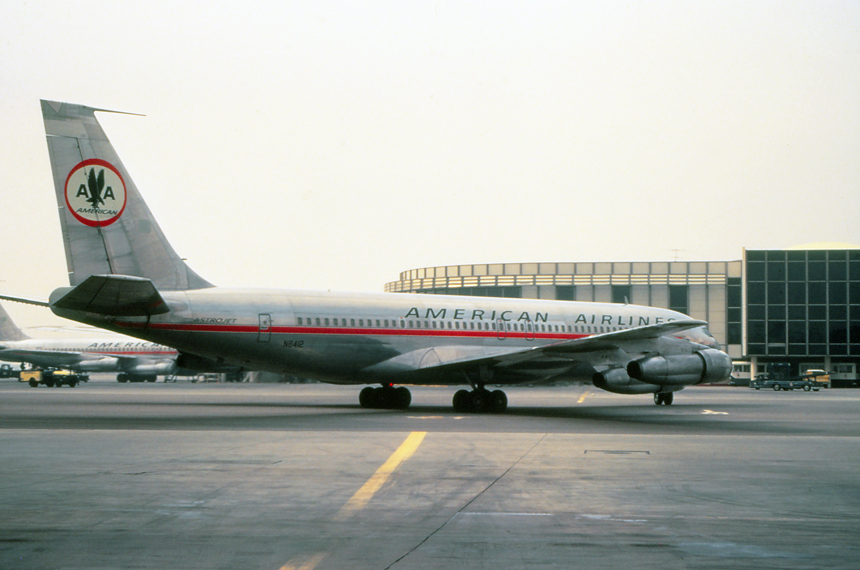
| July 1970
American Airlines entered the Jet Age with the venerable Boeing 707. Realizing the opportunity for the next chapter in aviation history, American placed an order for twenty-five of the Boeing 707s in 1955, and become the first US "domestic" airline to order the new plane. American's new "707 Jet Flagship," would accommodate 112-passngeres in a two configuration cabin, along with a first class "lounge" in the forward section. The first plane was delivered in October 1958, and scheduled service was inaugurated on the ever popular Los Angeles to New York route on January 25, 1959. American became the first airline to place the Boeing 707 on domestic, coast-to-coast services. Eventually as the Boeing 707 evolved into the Model 720 and the -300 series with "fan jet" engines and intercontinental ranges, American would operate these variants, with the Boeing 707 becoming the foundation of the medium and long range fleet. By the 1970s, Los Angeles saw the 707 used on flights to no less then eleven cities flown by the carrier from the airport. Turning in toward the gate at Satellite Terminal Building 4 during an overcast morning is N8412, a Boeing 707-323C, delivered new to American Airlines on June 4, 1968. |

| August
1970 One of the busiest times at Los Angeles International Airport was the morning "rush" as airlines sought space for their departures eastbound. It was not unusual to see a line of aircraft sometimes ten long awaiting their turn for takeoff. A typical summer morning shows a United Airlines Boeing 720, followed by a Continental Airlines Boeing 747 then an American Airlines Boeing 707 awaiting takeoff on Runway 24. |

|
September 1970 During a time when Bigger was Better, Trans World Airlines (TWA) placed an order for the Boeing 747 "Jumbo Jet" with deliveries of the new plane scheduled for 1969. The new 747 with a capacity of 342-passengers was to be used on heavy domestic and the popular transcontinental routings. Los Angeles was host to the first passenger TWA Boeing 747 service on February 25, 1970, with flights to New York-JFK Airport. TWA would eventually operate thirty-seven of the Boeing "Jumbos" including the Special Performance "SP." Starting to flare for landing during an early evening arrival on Runway 24 Left is N93109, a Boeing 747-131. |

|
September 1970 Air West acquired five of the smallest Douglas DC-9 series aircraft originally flown with West Coast Airlines and Bonanza Air Lines. Seen holding short of Runway 24 Left for departure on a bright fall morning is N9102, a Douglas DC-9-14, originally delivered to West Coast Airlines November 4, 1966. |

| December 1970 Delta Air Lines ordered five of the Boeing 747 airplanes for transcontinental services. With the first plane delivered in the trademark “Widget” in September 1970, services were inaugurated on an Atlanta-Dallas-Los Angeles route on October 25, 1970. As with many of the airlines, Delta soon realized that in order to operate the 747 cost effectively, they needed large, consistent volumes of traffic and the transcontinental routes just couldn’t support the increasing costs of the 747. After careful consideration and evaluation, it was decided that the 7Boeing 747 was not economical for the Delta route profiles and the last plane was removed from service in April 1977. Seen taxiing up to the hold short position for Runway 24 Left for a morning departure is, N9897, a Boeing 747-132, delivered to the airline just a month earlier on October 22, 1970. |
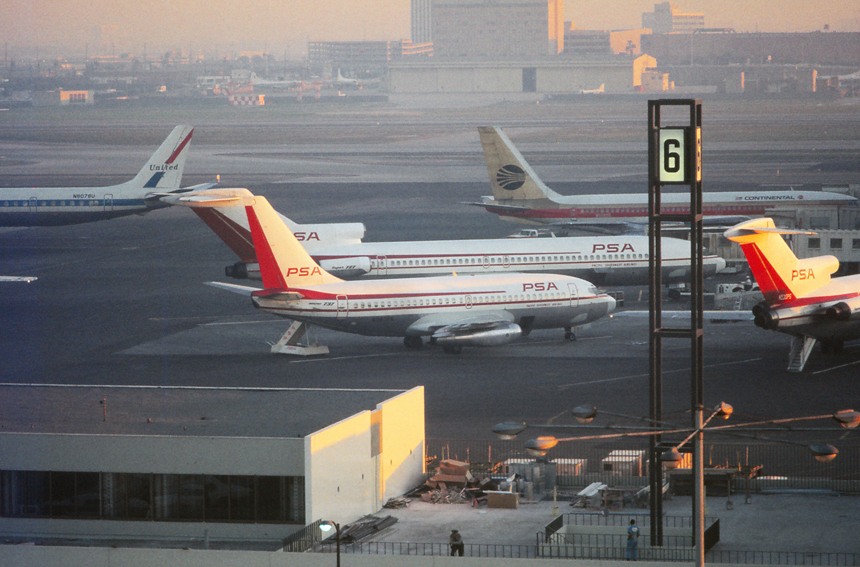
| January
1971 A busy ramp during a crisp winter evening at Satellite Terminal 6, home to both Pacific Southwest Airlines (PSA), Continental Airlines and Delta Airlines. Parked at the terminal and awaiting its turn-around service is N387PS, a Boeing 737-214, flanked by two company 727-200s. |

|
January 1971 Overseas Terminal/Satellite 2 at Los Angeles International Airport was designated for international flights and saw a variety of airlines on Europe during the early 1970s, including Air France and SAS Scandinavian. SAS had flights to both Bergen and Copenhagen via Seattle three times a weekly using the Douglas DC-8. Seen being readied for an evening departure at Satellite 2 is SE-DBH "Ring Viking," a Douglas DC-8-63. |

| January
1971 Trans World Airlines (TWA) introduced the Boeing 707 "Star Stream" and ushered in the jet age for the airline on March 20, 1959, between New York and San Francisco. As additional 707s were delivered, they were placed on the more popular routes in the network including flights from Los Angeles to Chicago, Baltimore, St. Louis, New York, Kansas City, and San Francisco. Parked at Satellite 2 and being unloaded and serviced after a flight is N8736, a Boeing 707-331B, delivered new to TWA in May 1969. |
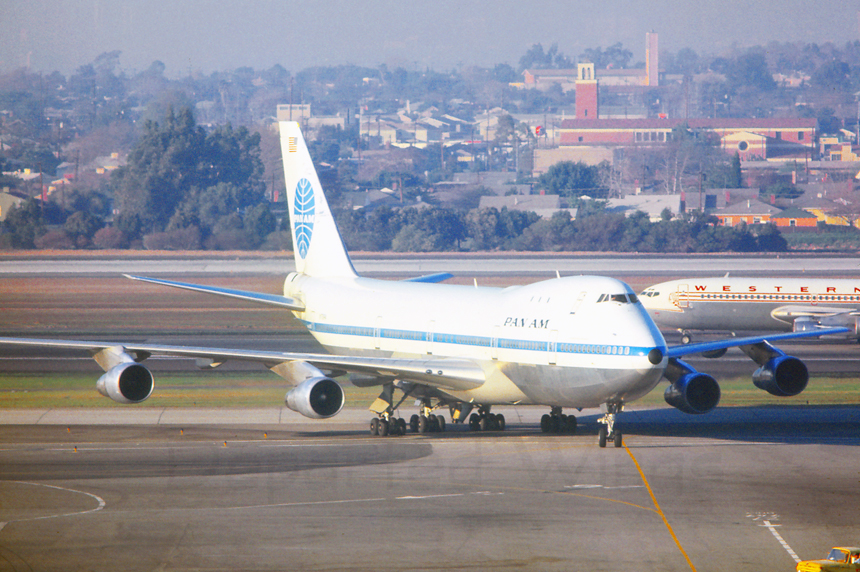
| January
1971 Pan Am Airlines' introduced the Boeing 747 to Los Angeles in early 1970 with flights to Honolulu and daily non-stop service to London. The new "Jumbo Jets" were a hit and with the catching advertising of "The plane with all the room in the world," made Pan Am a top choice for trans-Atlantic travel from the West Coast. Seen taxiing into the ramp of Satellite 2 during an early evening arrival is N770PA "Clipper Great Republic," a Boeing 747-121, delivered new to Pan Am on May 31, 1970. |

| January
1971 National Airlines received its first Douglas DC-8 in February 1960, and with the Boeing 727s delivered four years later transitioned to an all jet fleet. Douglas DC-8s soon replaced National Airlines leased Boeing 707 flights between the lucrative Miami-New York-Idlewild route in early 1960 with ten daily round-trip schedules. The Douglas DC-8s would play a key role in providing trans-continental services when National was awarded routes to the West Coast including Los Angeles, San Francisco, and San Diego in 1961. By 1971, National Airlines was using the Douglas DC-8 on flights from Los Angeles to Miami, Tampa, New Orleans, Houston, and San Diego. Seen taxiing toward the south runways, for a morning departure is N7182C "Beverly," a Douglas DC-8-32, originally delivered to Northwest Airlines in 1960, and purchased by National Airlines on October 14, 1963. |
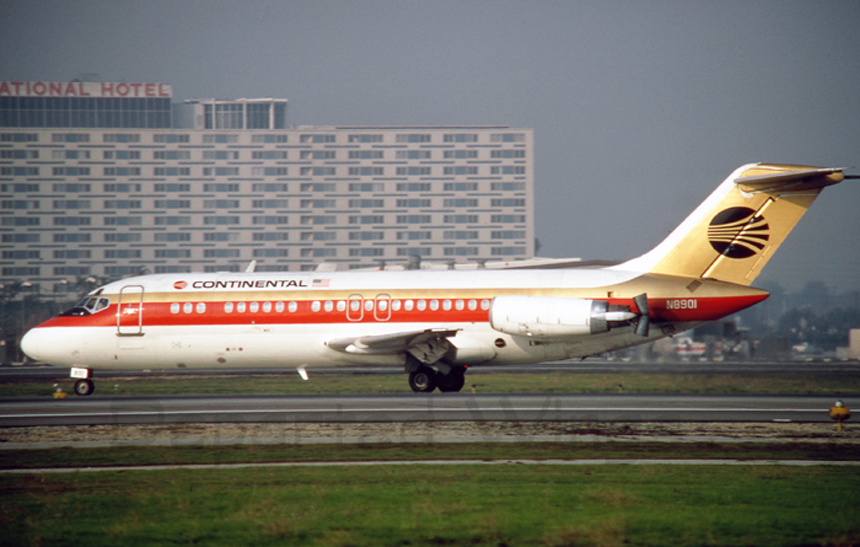
|
February 1971 With a capacity of only eighty-three passengers, Continental Air Lines Douglas DC-9-15 was the smallest passenger jet aircraft in their fleet at the time, and hence from Los Angeles continued to serve only El Paso, Texas with two daily flights into the early 1970s. Seen rolling out on Runway 25 Left with thrust reversers deployed is N8901, a Douglas DC-9-15RC and the first to be delivered to the airline on March 7, 1967. |
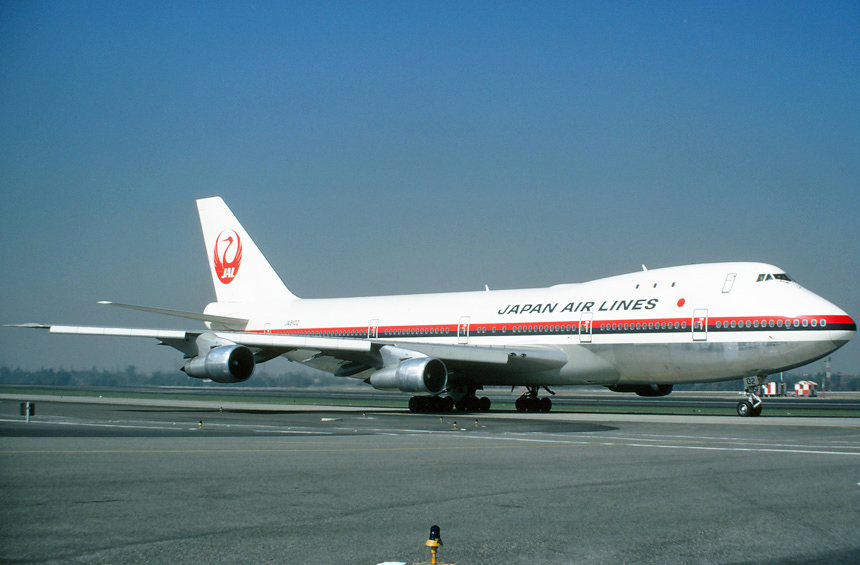
|
February 1971 Japan Airlines (JAL) was an early international operator into Los Angeles when service was started to Tokyo in 1959 using a Douglas DC-7C via Honolulu, Hawaii. The piston-engine equipment was replaced in the early 1960s with Douglas DC-8 jet aircraft. JAL ordered the Boeing 747 "Jumbo Jet" in 1968 to provide greater comfort, range and capacity on its Pacific routes. The airline received its first 747 in May 1970 and the plane inaugurated service in July of that year on a Tokyo-Honolulu-Los Angeles routing. Los Angeles would continue to host both the passenger and later freighter version of the Boeing 747 well into the late 1990s. Taxiing along Taxiway Uniform enroute for departure on Runway 24 Left is JA8102, a Boeing 747-143 and the second example to be delivered to JAL in May 1970. |
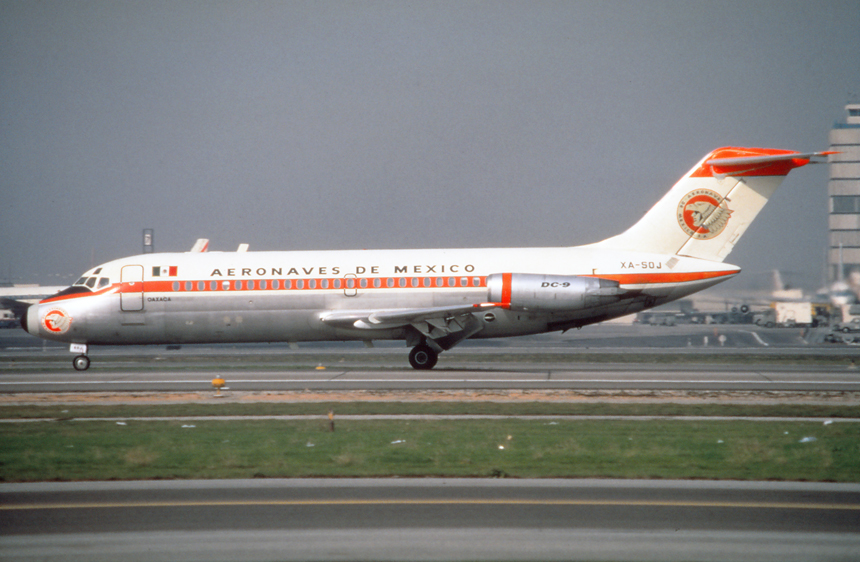
| February
1971 By 1971, Aeronaves De Mexico had increased flights to Los Angeles by adding non-stop service to both Tijuana and Ciudad Juarez in addition to the existing Los Angeles-La Paz-Mexico City service using both Douglas DC-9s and DC-8 equipment. Seen rolling out after having landed on Runway 25 Left on a hazy afternoon is XA-SOJ "Oaxaca," a Douglas DC-9-15, originally delivered to Swissair in 1966, and purchased by Aeronaves in August 1970. |

|
February 1971 Continental Air Lines was one of the launch customers of the Boeing 747 Jumbo Jet and was the second airline to place the plane in domestic service on June 26, 1970. The airline's 747 was an example of luxurious flying at the time and was equipped with an upper deck first class lounge and a "Polynesian Pub" on the main deck. With a capacity of over 300 passengers, the 747 was placed on the popular Chicago-Denver-Los Angeles-Honolulu service. The plane proved quite popular, however due to the oil embargo, consolidation of fleet, and the use of the better placed Douglas DC-10s, Continental removed the Boeing 747 from passenger services in 1978. Seen turning onto Runway 24 Left for a morning departure is N26862, a Boeing 747-124. |
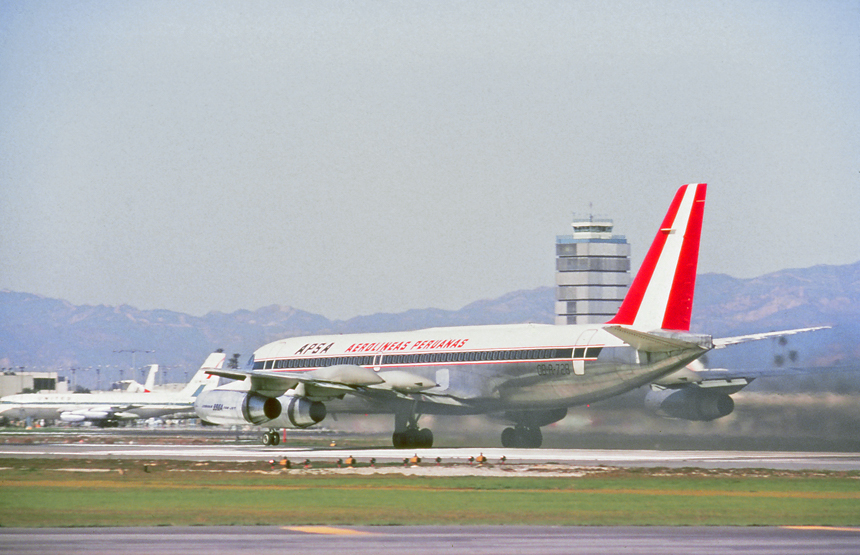
| March
1971 Established in September 1956, Aerolinas Peruanas SA (APSA) was started to provide connections from Lime to neighboring countries in South America. eventually the airline expanded into North America with the addition of services to both Mexico City and Miami. In 1963, the airline took the bold step of acquiring a Convair 990 "Coronado" jets for its international services. When a second 990 was delivered the airline extended its reach and inaugurated services to Los Angeles in 1966, with a Lima-Acapulco-Los Angeles routing. (A second route was Lima-Guyaquil-Mexico City-Los Angeles). APSA become the second South American carrier to start international services into Los Angeles, the first being Varig Brasil. Due to financial impacts of expanded services to Europe and mounting debt, the airline ceased operations a few months later in May 1971. Rolling for takeoff on Runway 25 Left with the four General Electric CJ-805-23s "smoking" is OB-R-728, a Convair CV-990-30A-6. |

|
March 1971 As an aircraft between the longer range Boeing 707/720 and the shorter-range, smaller capacity Boeing 737, Western Airlines placed an initial order for six Boeing 727-200 airplanes with the first three being delivered on October 16, 1969. The new Boeing 727s were to be used on higher density, short and medium haul services including flights from Los Angeles to San Francisco, Seattle, and Las Vegas. Seen taxiing on Taxiway Foxtrot for an afternoon departure is N2803W, a Boeing 727-227, delivered new to the airline n October 16, 1969. |
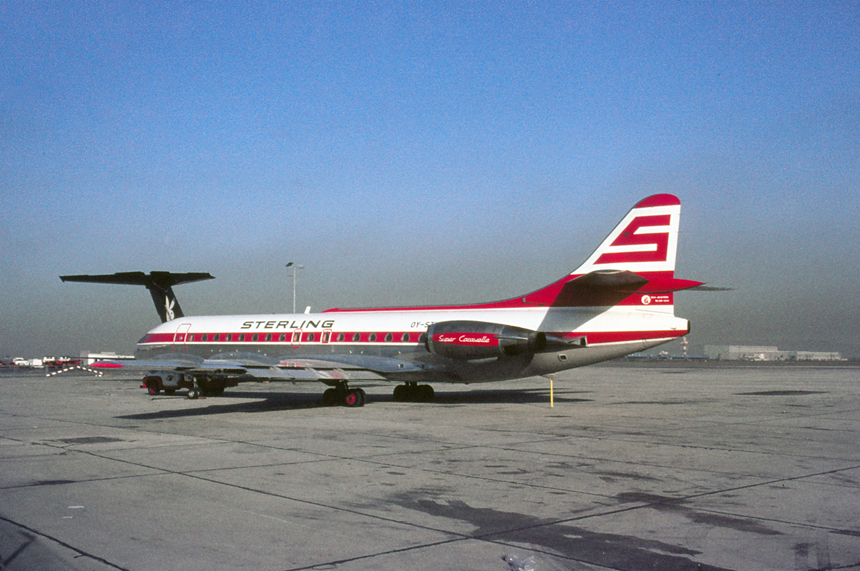
|
March 1971 Denmark based Sterling Airways was founded as a charter airline in May 1962, using two Douglas DC-6s on "budget holiday" tours to Spain and Southern Europe. Caravelle "jets" were added in 1965, brining modern comfort to passengers as well as extended range and capacity. The Caravelle's were mainly used on charters and tour group flights throughout Europe however the planes were occasionally spotted across the Atlantic, such as this example OY-STM, a Sud Aviation SE-210 Caravelle 10B3 "Super B," parked at the Imperial Terminal during a "holiday" charter to Los Angeles. |
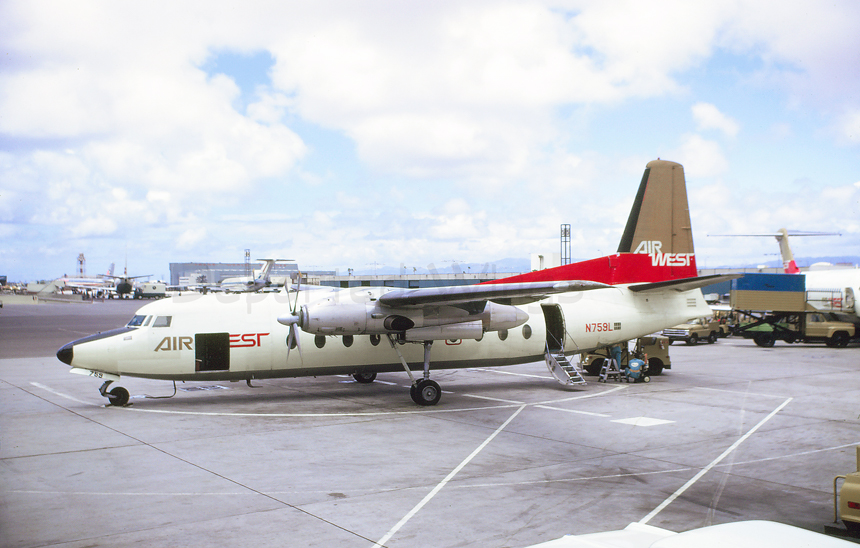
|
May 1971 Even after the purchase of AirWest by Howard Hughes on April 1, 1970, it would take a few years to transition to the new "Sundance Yellow" and "Universal Blue" color scheme preferred by its new owner. Parked on a busy ramp at Satellite 6 and being prepared for a mid-day departure is N759L, a Fairchild F-27A, originally delivered to Bonanza Air Lines in April 1965. |
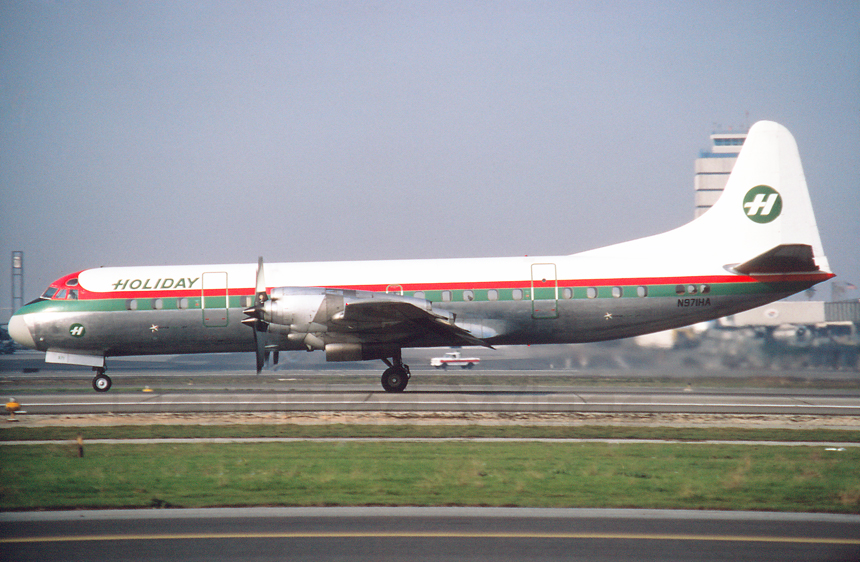
|
May 1971 Holiday Airlines started operations in November 1968 as an intrastate carrier to provide scheduled passenger flights to lake Tahoe, which ad banned pure jet operations. Using three Lockheed L-188 "Super Electra's," Holiday Airlines initially started service to lake Tahoe from San Jose and Hollywood-Burbank Airports. Los Angeles was added with non-stop daily Lake Tahoe service in 1970 with operations from the Imperial Terminal. Holiday continued to operate the only scheduled service to Lake Tahoe from los Angeles until 1975, when the airline filed bankruptcy. Seen rolling for takeoff on Runway 25 Left is N971HA, a Lockheed L-88 Electra-C. |
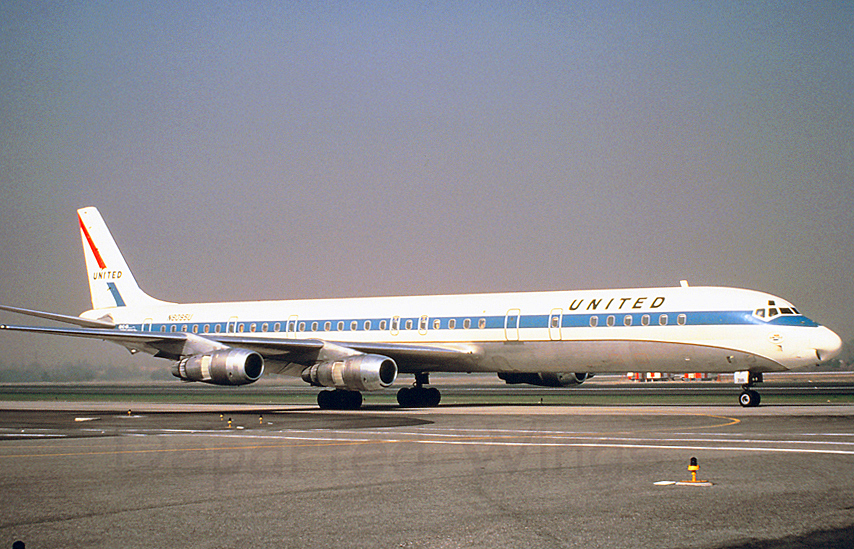
|
June 1971 Seeing an opportunity for increased capacity using the existing Douglas DC-8 airframe, Douglas engineers "stretched" the existing DC-8 and United Air Lines was the first airline to sign on to purchase the new 60-series. Advertised as the "Super DC-8," United started service with the aircraft on February 24, 1967. With a passenger capacity of 198-seats in a two class configuration, the plane was initially used on California to Hawaii services including Los Angeles-Honolulu. Seen taxiing toward Runway 24 Left for a morning departure is N8095U, a Douglas DC-8-61, delivered new to the airline on May 15, 1969. |

|
June 1971 United Air Lines placed a substantial order for forty (40) Boeing 737 aircraft in 1965, to replace the aging Convair CV-340 and various Douglas piston airliners remaining in the fleet. United took delivery of its first 737 in December 1967 and these were quickly placed on short and medium range routes throughout the network. Los Angeles received the Boeings in 1969, to replace the Convair CV-340s on various regional routes within the state including services to Bakersfield, Fresno, Monterey, and San Francisco. Seen taxiing out for a morning departure is N9016U "City of Dayton," a Boeing 737-222 |
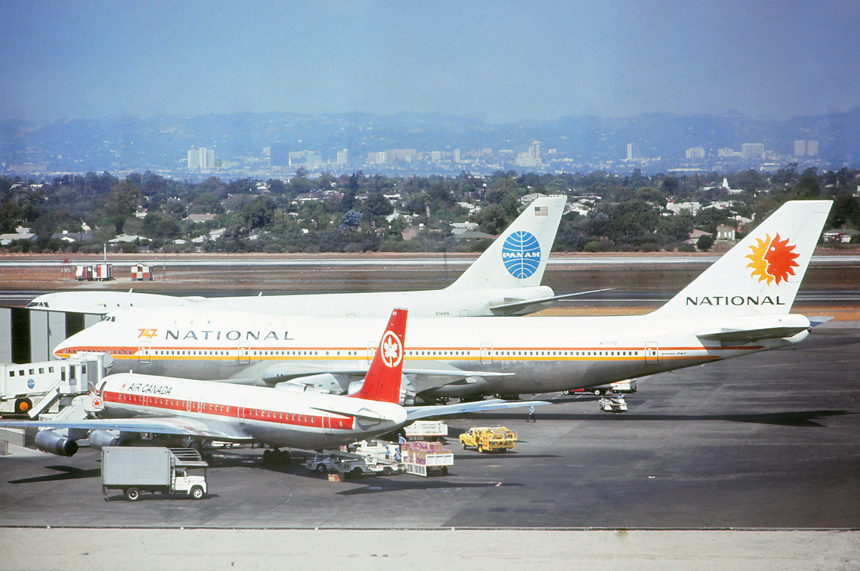
| July
1971 By the early 1970s, Los Angeles was host to over fifteen different international airlines as well as all the major domestic carriers, with many providing services using their new Jumbo Jets. A typical summer scene at a busy Satellite Terminal 2 shows Pan Am N744PA, a Boeing 747-121, National Airlines N77773, a Boeing 747-135, having just pulled into the terminal and Air Canada CF-TIP, a Douglas DC-8-60. |
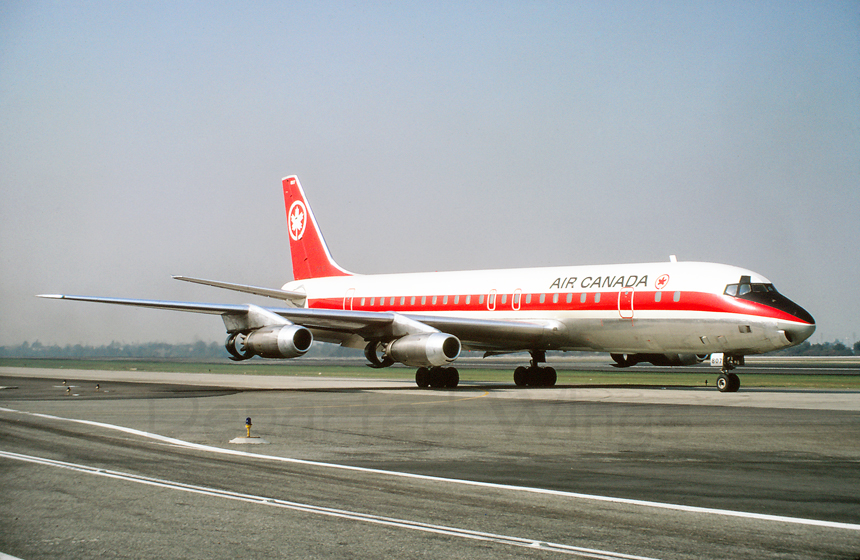
|
August 1971 Air Canada placed an initial order for the Douglas DC-8 and was one of only three airlines to purchase the option using Rolls-Royce Conroy turbojet engines, dubbed a -40 series. The first DC-8 was placed into transcontinental service with the airline on April 1, 1960 and international service two months later on June 1, 1960. Seen taxiing toward Runway 24 Left for a morning departure eastbound is CF-TJG, a Douglas DC-8-43, originally delivered to Trans Canada Air Lines (TCA) on December 12, 1960. |
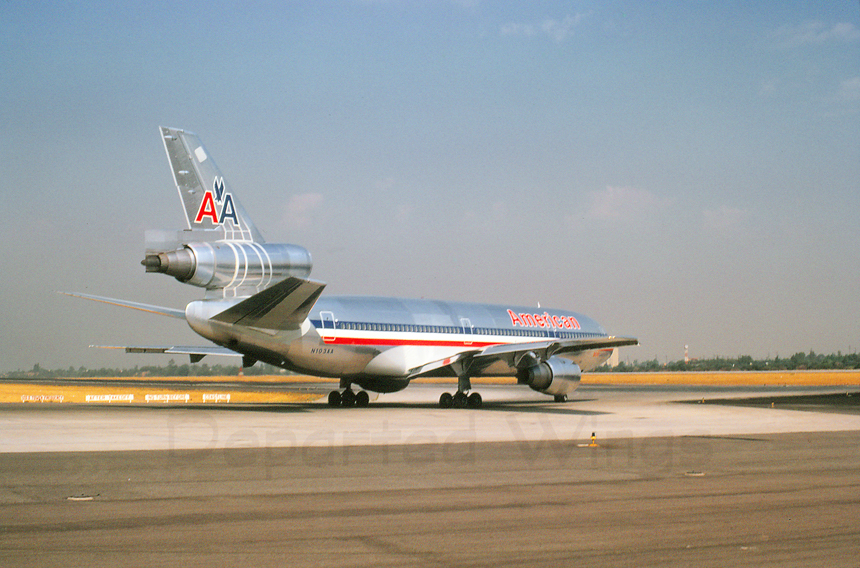
|
August 1971 As one of the launch customers for the Douglas DC-10, American Airlines placed into service it's first Douglas DC-10 on passenger service between los Angeles and Chicago-O'Hare on August 5, 1971. Caught heading out toward Runway 25 Left for a morning departure to Chicago on it's inaugural passenger service is N103AA, a Douglas DC-10-10, delivered new to the airline just a week earlier on August 29, 1971. |

|
April 1972 United Airlines was one of the original operators of the Boeing 747. United took delivery of its first "Jumbo" in June 1970, and became the first airline to place the 342-passenger plane on the trans-Pacific service to Honolulu with non-stop flights from San Francisco. Los Angeles soon saw the United 747s a few months later, being placed on services to Chicago, Honolulu, New York-JFK, and Seattle. On final approach to the north runways with a view of the Baldwin Hills in the back is N4719U, a Boeing 747-122. |
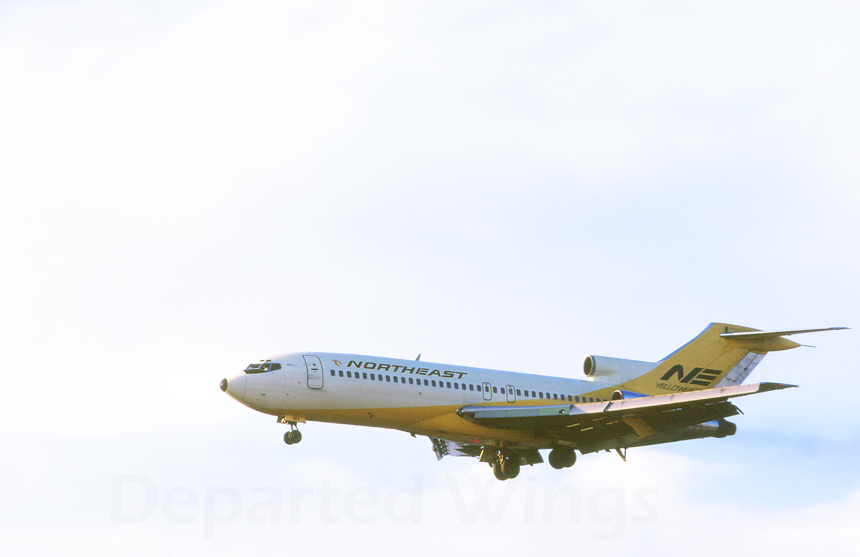
| July 1972* A rather unique airline to add Los Angeles to its route map was Boston based Northeast Airlines. Northeast had established itself as a respectable trunk carrier operating along the Eastern Seaboard and Florida. The airline received approval by the Civil Aeronautics Board (CAB) as part of the Southern Transcontinental route case a non-stop Miami to Los Angeles route in September 1969. Understanding the competition with National Airlines on the route, Northeast placed its smaller Boeing 727-100s on the non-stop service, pushing the range limits of the aircraft, which commenced October 1, 1969. Northeast continued to serve the route until its merger with Delta Air Lines in August 1972. Seen on approach to Runway 25 Left during an early evening arrival is N1632 a Boeing 727-95, delivered new to Northeast on December 17, 1965. |

| August 1972 Los Angeles based Flying Tigers Line was established in 1945 to provide contract freight service. More commonly known as Flying Tigers, the airline was the first to be awarded a commercial air cargo route in the United States by the Civil Aeronautics Board (CAB) in 1949. The early cargo routes were from both Los Angeles and San Francisco to Boston using Curtis C-46 cargo aircraft. As the cargo carrier grew, more destinations and aircraft were acquired. With the dawn of the jet-age, Douglas DC-8 Freighters were ordered and put into service providing more efficiency, capacity and speed with cargo deliveries. Rolling for take-off on Runway 25 Left is N796FT, a Douglas DC-8-63CF. |

| May
1972 During the late 1960s and early 1970s, Los Angeles continued to host new international carriers from countries both near and afar. Once such airline to start service was Avianca, the national airline of Colombia which started flights into Los Angeles as an extension of its Bogota-Panama City-Mexico City service in July 1969. Boeing 707 jets were used on the new service with the airline becoming the third South America airline to join the international ranks at Los Angeles. Taxiing in toward the gate for the International Arrivals at Terminal 2 is HK-724, a Boeing 720-059B. |

| August
1972 Eager to be part of the new "Jet" club, Continental Airlines placed an order for four of the new Boeing 707 airplanes in 1955. Staring as Varney Speed Lines in 1934, with a single route between El Paso, Texas and Pueblo, New Mexico, the local carrier slowly grew and renamed itself Continental Airlines in 1937. Over the next twenty years, the airline continued its growth mainly in the Southwest United States and formed interline agreements with both Braniff Airways and American Airlines. When the airline placed its first Boeing 707 into service on June 8, 1959 between Los Angeles and Chicago, it rose to the ranks of the "majors" of which many still didn't have true jet service. The sleek, four-engine transport was painted in the carriers colors at the time; black and gold, and dubbed the new plane "Golden Jet." Pleased with the performance and characteristics of the Boeing 707, they deiced to order the "Hot Rod" version of the legendary plane; the Boeing 720. With an order for eight, the first was placed into service on June 3, 1962 and become a familiar site on the trunk routes of the carrier. Considering Los Angeles became home base for the carrier in the 1970s, the Boeing 720 was used on most of the domestic city pairings including Chicago, Colorado Springs, San Antonio, Phoenix, and Tucson. The Boeing 720 remained a significant portion of Continental's medium-haul fleet until they were removed from service and replaced with the Boeing 727 in the late 1970s (1976-1977). Seen rolling out on Runway 25 Left after landing is N57205, a Boeing 720-24B, delivered to Continental on May 11, 1963, and wearing the familiar Saul Bass color scheme. |

|
October 1972 Delta Airlines was similar to fellow major airlines in providing a cargo only type service. Early cargo only service utilized the Curtis C-46 to provide transport of air freight throughout the southeastern United States. To replace the aging C-46s, Delta placed an order for the high-wing, all-cargo, four-engined turboprop, the Lockheed L-100, for which it became one of the first commercial operators of the type. The first plane was delivered in August 1966, and Delta used the new freighters to mainly carry engines and spare parts throughout its network. With the introduction of wide-body passenger aircraft such as the Boeing 747 and Douglas DC-10 which more spacious under floor cargo space, the need for cargo specific aircraft was diminished and Delta sold it L-100 fleet in 1973. Taxiing outbound for takeoff is N9259R, a Lockheed L-100-20 "Hercules," delivered new to Delta on September 17, 1966. |

| January 1973* National Airlines received its first of two Boeing 747s, in September 1970 with scheduled services being inaugurated on October 2, 1970 on the popular New York-Miami route. A few weeks later flights were started from Miami to Los Angeles, and becoming the first airline to offer 747 “wide-body” services in that market. National’s Boeing 747s were placed on the Miami-London route during the summers starting in 1972, than placed back into the domestic service rotations. The size and operating costs of just two aircraft was uneconomical for the airline, and both 747s were sold to Northwest Orient in May 1976. Seen approaching Runway 6 Right for an early evening departure under reverse traffic flow is N77773 "Linda," a Boeing 747-135, delivered new to National Airlines on October 20, 1970. |
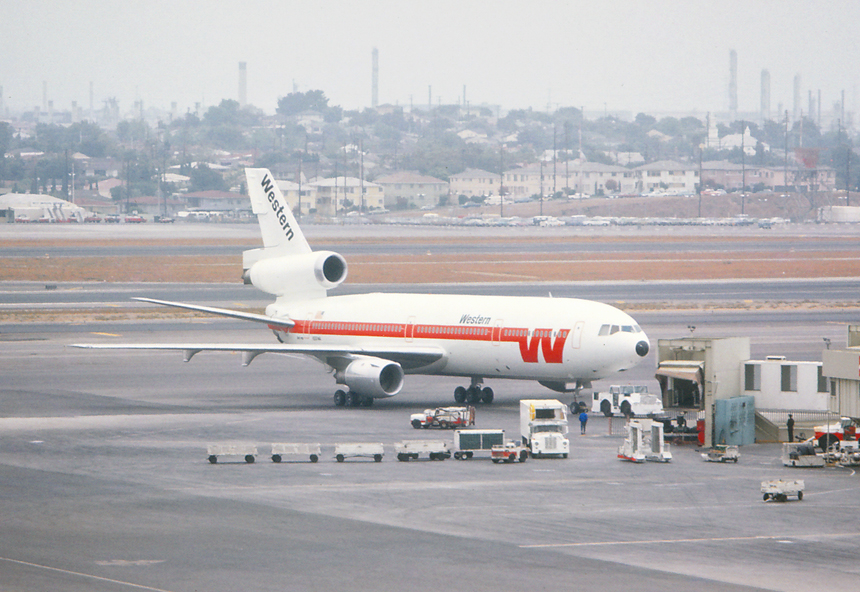
| May
1973 Los Angeles based Western Airlines ordered nine Douglas DC-10s in 1972, to provide passenger capacity and increased range on some of its most popular routes. The first DC-10 was delivered to Western Airlines on April 19, 1973. With a capacity of 254-passengers the new "heavy" aircraft were placed on the Minneapolis-St. Paul-Los Angeles-Honolulu service in May 1973. Seen being pushed back from the gate at Satellite Terminal 5 during an overcast morning is N901WA, a Douglas DC-10-10, was Western first DC-10 delivered new just a month earlier. |

| May
1973 Supplemental airline World Airways received its first government contract in 1951, and the transport of military troops, cargo, and other government charters became the mainstay of the company. Having introduced jet aircraft in 1963, the airline became the launch customer for the Boeing 747 Cargo version with the "flip-up" nose that makes for more efficient loading of bulk and larger cargo pallets. Their first Boeing 747 was delivered in April 1973, and this was followed by two additional airframes. The new 747s increased range, speed, and capacity on both domestic and international charter routes. Seen taxiing toward Runway 24 Left on an overcast morning is N747WA, a Boeing 747-273C, delivered new to the airline just a month earlier on April 27, 1973. |

| May
1973 The United Kingdom's largest independent airline was formed in 1970 with the merger of Caledonian Airways and British United Airways. Based at London Gatwick Airport, British Caledonian was operating eight Boeing 707-300 series aircraft for long range scheduled and charter services to both Africa and North America. During April 1973, British Caledonian started five-times-a-week, non-stop flights to Los Angeles from London Gatwick Airport using the Boeing 707 on the long-range service. Pulling into the gate at Satellite 2 is after a trans-Atlantic flight is G-AWWD "County of Argyll," a Boeing 707-349C, originally delivered to Caledonian Airlines in January 1969. |
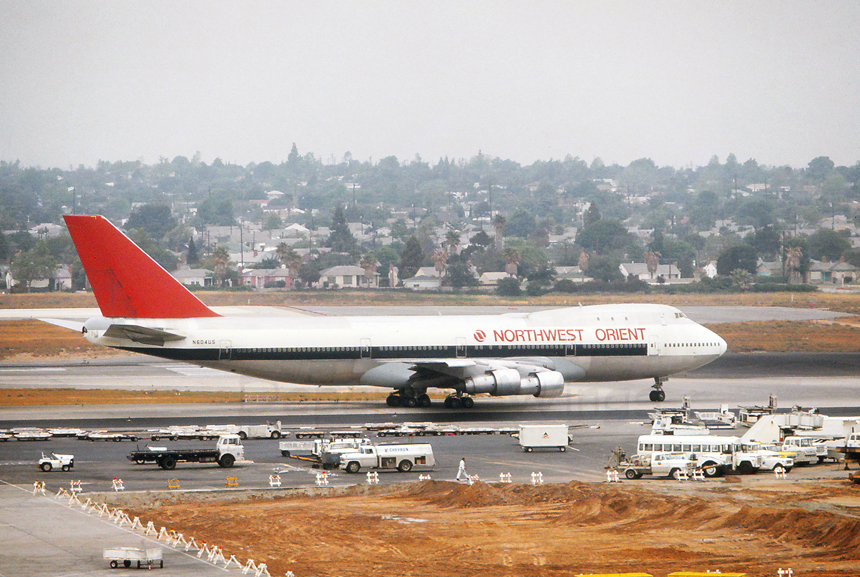
|
May 1973 Northwest Orient Airlines placed an order for ten Boeing 747s in 1969, with the first being delivered in 1970. With a capacity of 369-passengers Northwest Orient introduced the Boeing 747 into service on June 22, 1970, between Minneapolis-St. Paul and New York-JFK. As more 747s were delivered they began to replace the Boeing 707 on trans-Pacific flights as well as being used on the dense transcontinental routings. Service to Los Angeles started in October 1969 using Boeing 707s, however these were replaced with the delivery of Boeing 747s on flights to both Minneapolis-St. Paul and Honolulu in 1971. Seen taxiing out for a morning departure under and overcast sky is N604US, a Boeing 747-151, delivered new to the airline on June 24, 1970. |

| June
1973 San Diego based intra-state carrier Pacific Southwest Airlines (PSA) had made Los Angeles its hub of operations. With flights within the state only, the airline dominated the infamous Los Angeles-San Francisco corridor and was popular with business and pleasure travelers alike. With low fares, frequent flights and their characteristic in-flight services PSA was formidable presence at the airport. By 1973, PSA was serving six cities from Los Angeles with over fifty daily departures. Taxiing out to Runway 24 Left for a morning departure is N538PS, a Boeing 727-214. |

| February
1974 Established Union de Transports Aeriens (UTA) become the largest, independently owned airline in France and was the result of the merger between UAT and TAI airlines in 1963. Los Angeles was an early destination for UTA having assumed the city from predecessor airline TAI on the Papeete, Tahiti-Los Angeles transpacific route. The airline introduced the Douglas DC-10 in 1973 for both transpacific and African services, eventually operating seven of the type. Los Angeles hosted the DC-10s on the airlines popular non-stop service to Tahiti. Taxiing to the western remote pads for holding for a flight later that evening is N54639, a Douglas DC-10-30, delivered a month earlier to the airline on January 18, 1974. |
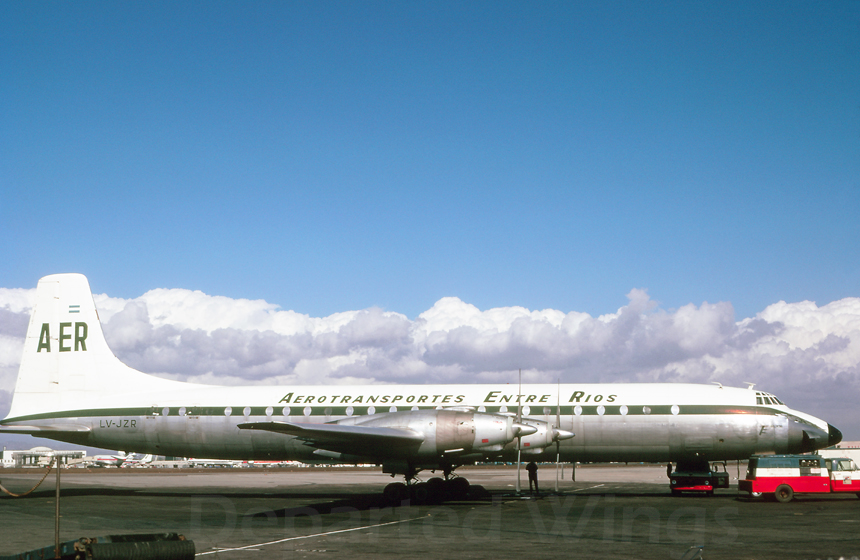
| April 1974* Los Angeles was host to numerous airlines both large and small that chartered flights into the airport. Aerotransportes Entre Rios was a non-scheduled freight carrier established in Argentina. Operations were initially centered around South America until 1965 with the U.S. Civil Aeronautics Board (CAB) gave approval for the airline to carry fright and mail to Miami, Florida. The carrier expended and became a big charter operator for both horse and livestock services. Both piston and turboprop equipment was used include the larger Canadair CL-44 and Bristol Britannia. The airline remained in service providing freight and livestock charters between South America, North America, and Europe until 1981. Seen parked at the Imperial Terminal during a charter flight is LV-JZR, a Canadair CL-44-6 (CC-106 Yukon.) |

| June
1974 It had just been two years since the British flag carrier British Overseas Airways Corporation (BOAC) was merged with British European Airways (BEA) to form British Airways. BOAC had been the original operator into Los Angeles when flights were started in 1961 using the Boeing 707 on non-stop service to London and the "new" British Airways would continue to serve the route. Seen rolling out on Runway 25 Left after an early evening arrival is G-AYLT, a Boeing 707-336C, delivered new to BOAC on May 28, 1971. |

| December 1974 The Douglas DC-9 had become the workhorse for both short and medium range services for Aeromexico in the 1970s. During the late 1960s, Aeromexico flew less popular routes to cross-border cities, not wanting to compete with other national carrier Mexicana which flew their dense trunk routes. The Douglas DC-9s were a perfect fit for flights from Los Angeles to the resort destinations of La Paz and San Jose del Cabo (Cabo San Lucas) both in Baja California, as well as to the industrial city of Monterrey located in northeastern Mexico. Shown taxiing along the outer ramp apron in the "new" Aeromexico color scheme adopted in early 1974, is XA-DEL "Chiapas," a Douglas DC-9-32. |

| December
1974 By 1974, the Boeing 737 continued to be used on regional flights from Los Angeles to Bakersfield, Fresno, Monterey, and San Francisco. The "baby" Boeings would be a familiar sight at LAX well into the 1990s. Seen in the patriotic "Stars-and-Bars" colors introduced in 1971, and taxiing along Taxiway Foxtrot is N9026U "City of Jacksonville," a Boeing 737-222, delivered new to the airline on September 5, 1968. |

| February
1975 A rather unique visitor to the Los Angeles International Airport was North Central Airlines, which had occasional tour group and sports charters to Los Angeles using its Douglas DC-9s during the 1970s. The "Herman Duck" would again visit Los Angeles, this time as a scheduled carrier when Republic Airlines (which was the result of the merger of North Central and Southern Airlines in 1979) purchased Hughes Airwest in 1980. Parked on the ramp in front of the Imperial Terminal is N953N, a Douglas DC-9-31. |
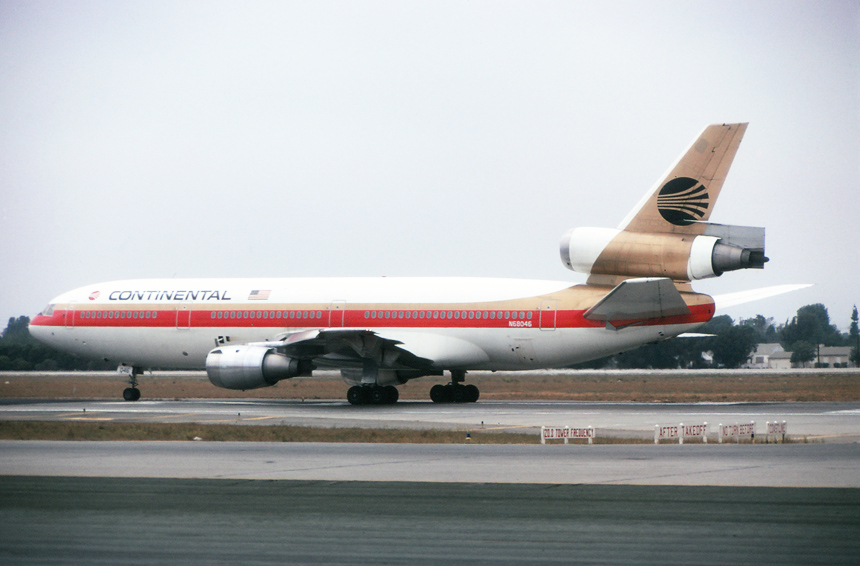
| June 1975 Continental Airlines was the fourth airline to order the new Douglas DC-10 Tri-Jet and eventually became the launch customer of the "Convertible Freighter" version ordering eight of the type. With deliveries of the DC-10 starting in 1974, Continental minimized its fleet by only operating two aircraft; the Boeing 727 and Douglas DC-10. The DC-10 was used on medium and long range sectors and the occasional short range-high density routes. Los Angeles was one of the first cities to host the DC-10 due to its high market status and saw the plane used on flight from LAX to Denver, Chicago, Houston, and Honolulu. Rolling for take-off on Runway 24 Left is N98046, a Douglas DC-10-10, delivered new to Continental Airlines on April 12, 1974. |

|
November 1975 Air Siam was a privately owned airline that started operations in September 1965 as a second carrier to provide passenger services to Thailand. Passenger flights didn't commence until March 1971, using a leased Overseas National Airways (ONA) Douglas DC-8 on flights from Bangkok to Tokyo, Honolulu, and Los Angeles. Realizing and opportunity for growth on trans-Pacific services, Air Siam placed an order for a Douglas DC-10 which was delivered new to the airline in November 1974. Twice weekly service to Los Angeles was started in April 1975, using the Douglas DC-10 on a Bangkok-Hong Kong-Fukuoka-Honolulu-Los Angeles routing. The airline didn't last long as increased expenses and competition with government owned Thai Airways forced the carrier to shutdown in December 1976. Holding in position for a morning departure on Runway 24 Left is HS-VGE, a Douglas DC-10-30, and the only DC-10 operated by the airline. |
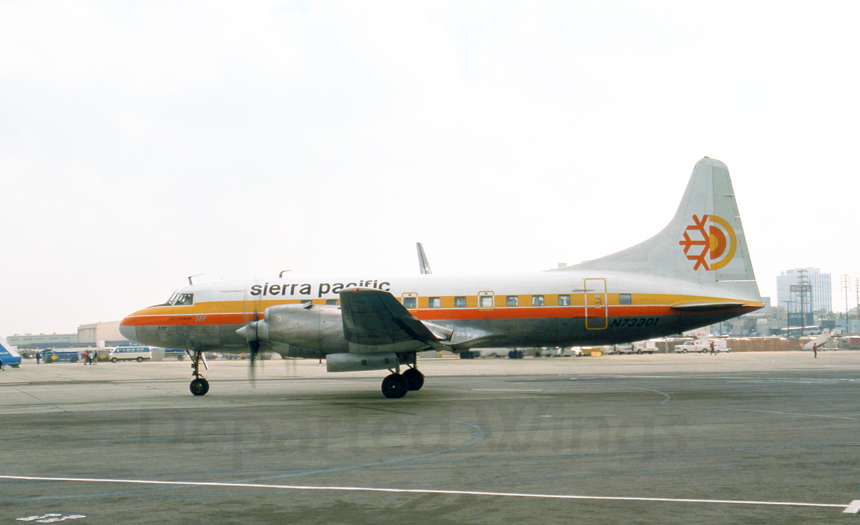
| December 1975*
Founded as Trans Sierra Airlines 1970 to provide charter flights to Bishop and Mammoth in the Eastern Sierras from both Los Angeles and San Jose. In 1971, the airline was renamed Sierra Pacific and used Aspen Airways as a model to provide schedule service initially using a Convair CV-440 and then the Convair CV-580 turboprop. Sierra Pacific would utilize the Imperial Terminal for arrivals and departures and by 1975 was providing three daily departures from Los Angeles to both Bishop and Mammoth. Seen taxiing away from the Imperial Terminal for a mid-morning departure is N73301,a Conavir CV-580 purchased by Sierra Pacific from Frontier Airlines in November 1974. |

| January
1976 Los Angeles was one of only two cities in the United States that Canadian airline, CP Air provided scheduled service to during its forty-five year history. The main reason was the Canadian Government favored national airline Air Canada, and CP Air initially was left to fly less than popular routes to overseas destinations, while Air Canada took priority on both domestic and trunk international routes. CP Air became a well respected carrier and established service to five continents before being merged with Pacific Western Airlines in 1987, forming Canadian Airlines. Los Angeles was added in April 1975, with non-stop flights to Vancouver, Canada using both the Douglas DC-8, Boeing 727, and later Boeing 737. The "Beautiful Orange" jets were popular with both business and tourist passengers on its one and only non-stop services to Vancouver. Taxiing toward Runway 24 Left for a morning departure to the north is CF-CPN, a Boeing 727-17. Note the logo just below the first passenger window advertising the 1976 Summer Olympic Games held in Montréal, Canada. |
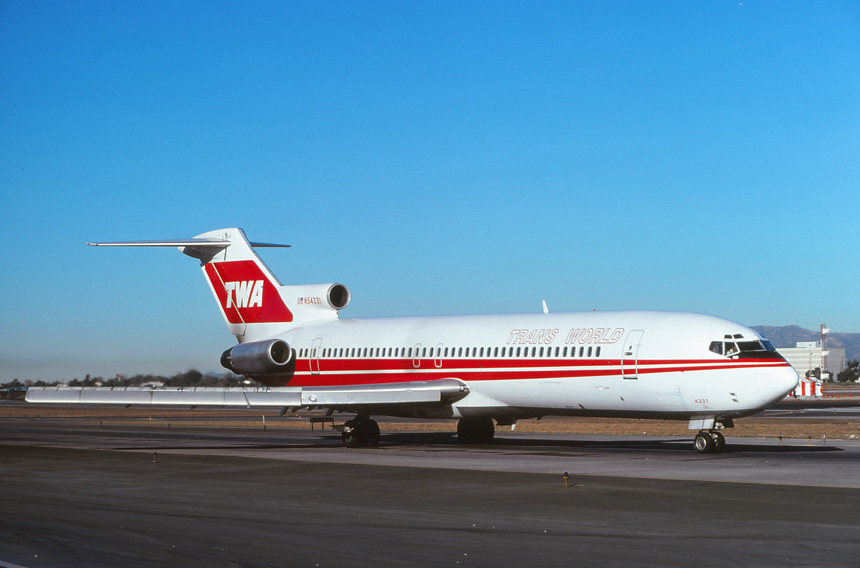
|
January 1976 Trans World Airlines (TWA) was an early operator into Los Angeles as Trans Continental & Western Airlines in 1930. TWA ordered the Boeing 727 airplane in 1963, to replace the aging Lockheed Constellations and supplement both the Convair 880 and Boeing 707s on short to medium range routes. TWA's first 727 went into service on June 1, 1964, between New York-JFK, and Indianapolis, Indiana. Los Angeles hosted the airlines 727s from the late 1960s on, for flights to Albuquerque, Kansas City, Las Vegas, Oklahoma City, Phoenix, St. Louis, and San Francisco. TWA would operate a total of seventy-three Boeing 727's well into the 1990s. Taxiing out for takeoff on a bright winter day and wearing the "new" TWA colors is N54331, a Boeing 727-231, delivered new to TWA on March 20,1970. |
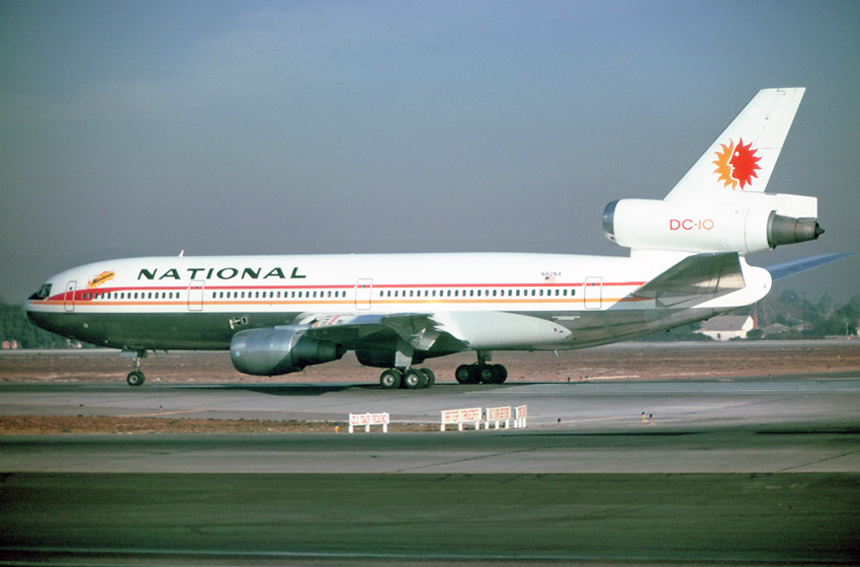
| February
1976 National Airlines finally received rights to start coveted service to Los Angeles from the Civil Aeronautics Board (CAB) as part of the Southern Transcontinental Route case in 1961. National had served Los Angeles since 1951 as part of an interchange agreement with both American and Delta Airlines. Douglas DC-8 jets were placed on new routes to Los Angeles from Houston, Tampa, and San Diego providing "Jet Star Service." National was a familiar sight at Los Angeles until its purchase by Pan Am Airlines in 1979. Taking the active Runway 24 Left for a morning departure is N82NA "Marianne," a Douglas DC-10-30 and the 200th DC-10 to be delivered by Douglas Aircraft. |

|
February 1976 Trans World Airlines (TWA) was one the launch customers for the technologically advanced Lockheed L-1011 airplane. Planning to use the wide body Tristar on trunk domestic routes, TWA ordered forty-four of the airplanes with the first plane being delivered in May 1972. TWA inaugural service with the L-1011 was from St. Louis to Los Angeles on June 25, 1972. During the 1970s the TWA's Tristars' were used on services from Los Angeles to St. Louis, Boston, Chicago, Indianapolis, New York-JFK, Philadelphia, Phoenix, Pittsburgh, and San Francisco. Lined up on Runway 24 Left and awaiting takeoff clearance is N81025, a Lockheed L-1011-385-1-15 Tristar 100. |

| May 1976 The first European airline to start service into Los Angeles was Scandinavian Airline System (SAS) in 1954 with an over-the-pole, multi-stop route using a Douglas DC-7C airplane. SAS became a loyal Douglas customer and eventually operated eleven Douglas DC-10s for use on international services to both North and South America, the Middle East and Africa. During the mid-1970s, DC-10 flights were started on a Los Angeles-Seattle-Copenhagen route twice a week. Parked at the Satellite Terminal 2 and being serviced for an evening flight to Copenhagen via Seattle is OY-KDA "Grom Viking," a Douglas DC-10-30. Note the CP Air Douglas DC-8 and Pan Am 747 in background. |
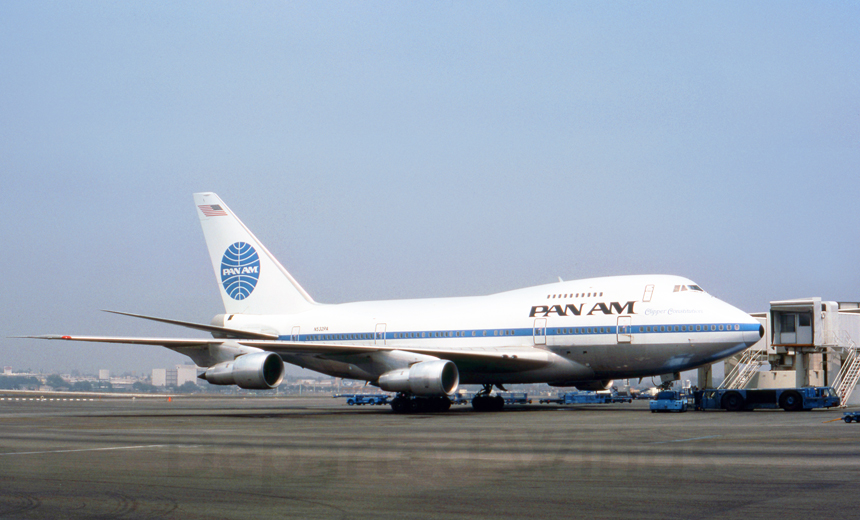
| July 1976 Although Boeing undertook the super-long range Boeing 747 "Special Performance" development without any firm airline orders, Pan Am was an early participant and showed considerable interest in the airplane. eventually becoming the launch customer and ordered ten of Boeing's Special Performance, long range 747s in 1973, with an option for an additional fifteen. Pan Am received its first aircraft on March 5, 1976 and placed the SP on the Los Angeles-Tokyo route on April 25, 1976. With further deliveries Pan Am placed the plane on the Los Angeles-Auckland in 1977 and Los Angeles-Sydney services in 1979. Sseen parked at the gate at Satellite 2 and awaiting another long-haul flight is N532PA "Clipper Consitution," a Boeing 747-SP21, delivered new to the airline on March 29, 1976. |
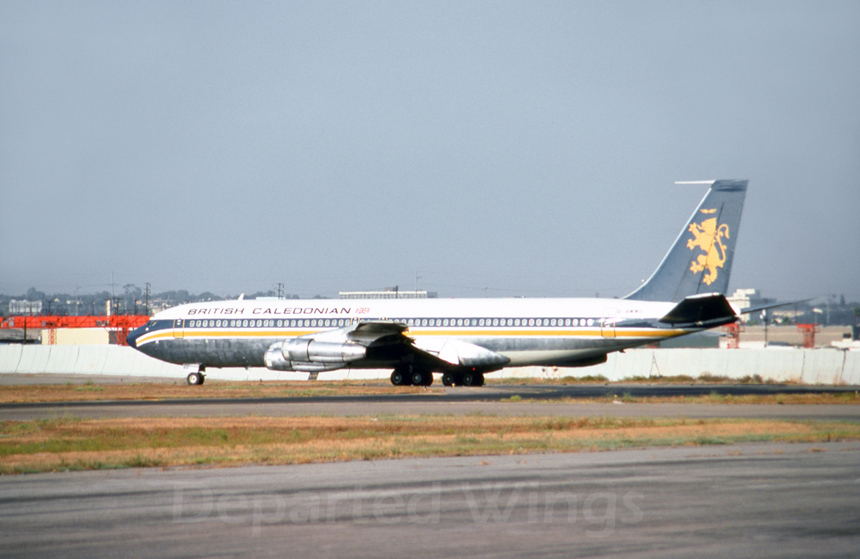
| July 1976* Although British Caledonian had started scheduled services from London-Gatwick in 1973, the carrier continued to provide charter flights from the United Kingdom for various tour group or vacation package "holidays" with Los Angeles being a popular destination year-round. Seen holding short of Runway 25 Left for an early evening departure on a charter flight back to London is G-AWWD "Country of Argyll," a Boeing 707-349C, initially leased to the airline from Flying Tigers in January 1969, before being purchased outright a year later in November 1970. |
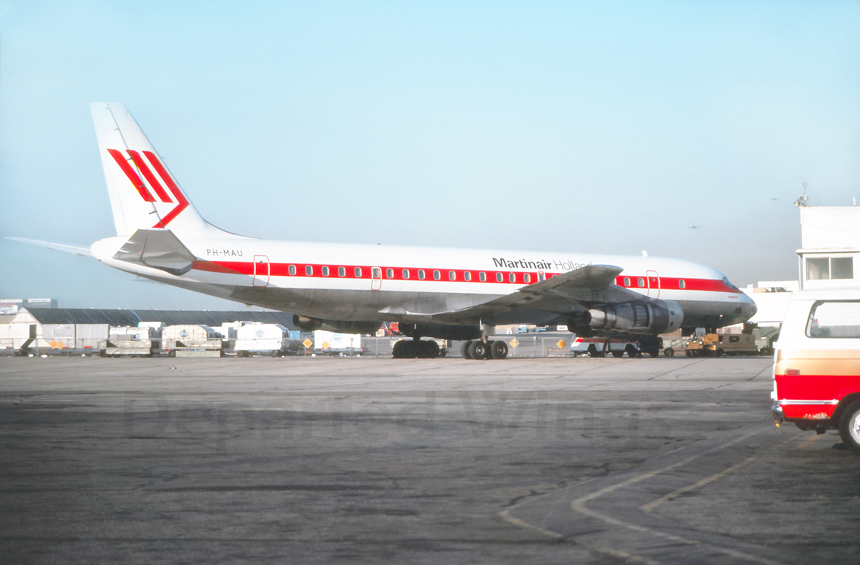
| July 1976* Martinair Holland started operations in 1958 using a Douglas DC-3 on air taxi services around the Netherlands. During the 1960s Martinair acquired Lockheed Electra's and its first jet aircraft; the Douglas DC-8 from KLM, which then owned a 25% stake in the airline, to start passenger charter flights. Los Angeles was a popular destination for both summer and winter charter flights and tour groups. Seen parked at the Imperial Terminal during a charter flight is PH-MAU "Toronto," a Douglas DC-8-55CF. |
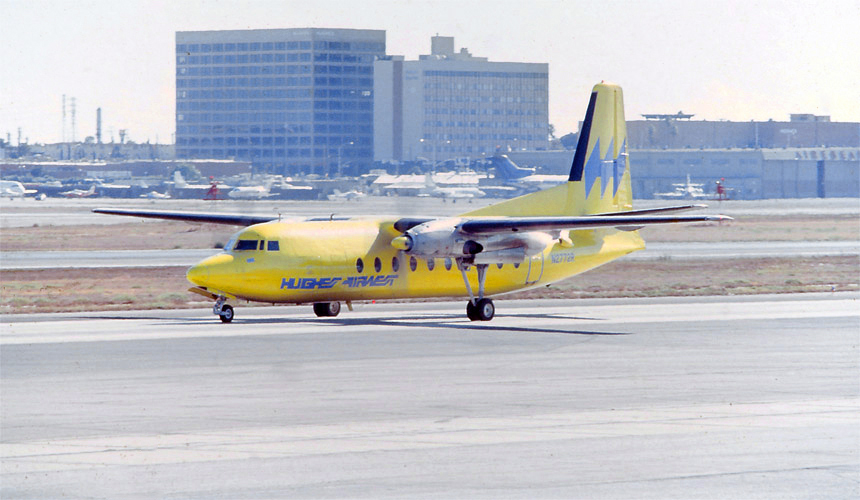
| August
1976 The Fokker/Fairchild F-27 was a frequent sight at Los Angeles when service was introduced by both Pacific Air Lines and Bonanza Air Lines in the early 1960s for local and regional routes. After the mergers resulting in Airwest and the subsequent purchase by Hughes Corporation to become Hughes Airwest, the reliable turboprops continued to serve small local or regional "thin" routes. From Los Angeles, the F-27 served cities such as El Centro-Imperial, Palm Springs, and Santa Maria. Taxiing out toward the south runway for a mid-day departure is N2772R, a Fairchild F-27A. |

| August
1976 The national airline of Canada, Air Canada, placed the Lockheed L-1011 into service during the summer of 1973, on a Toronto-Miami route. The new wide-body Tristar's were ordered to fill a gap on high density domestic services and medium-range international routes where the Boeing 747 was uneconomical. The Tristar was introduced on the popular Toronto-Los Angeles route in 1975 and continued to be used by the airline until the planes were retired from service in 1996. Having just taken the active Runway 24 Left for a mid-day departure is CF-TNJ, a Lockheed L-1011-385-1 Tristar. |
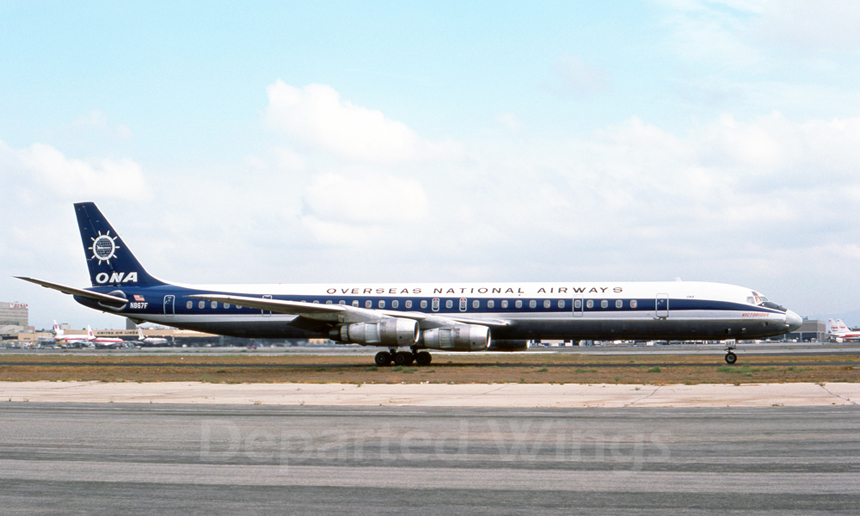
|
September
1976* Overseas National Airways (ONA) continued to provide regular passenger and military charters in Los Angeles into the 1970s. Due to the pending competition with the deregulation legislation passed in 1978, ONA was dissolved by its Board of Directors a few years later in October 1978. Seen taxiing along Taxiway Foxtrot enroute to Runway 25 Left for a mid-day departure is N867F "Victorious," a Douglas DC-8-61CF, purchased by ONA from Seaboard World Airlines in September 1973. |

|
September
1976* World Airways had introduced "jet" service with the introduction of both the Boeing 707 in 1963 followed by the Boeing 727 in 1967. As demand for various military, cargo, and passenger charters grew, World added the Douglas DC-8 to its fleet in 1971. The Douglas DC-8 "stretch" ordered by the airline was the "Convertible Freighter" version allowing full cargo, mixed passenger-cargo, or full passenger configurations. Seen taxiing along Taxiway Foxtrot for a morning departure is N803WA, a Douglas DC-8-73CF, delivered new to World Airlines on March 29, 1971. |
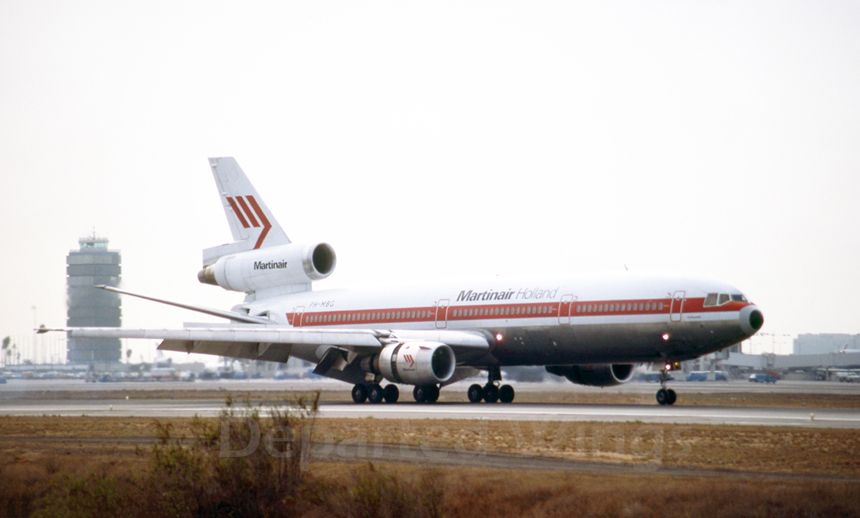
|
September
1976* In an effort to extend its global reach, Martinair Holland ordered four Douglas DC-10 convertible freighters for charter and contract cargo work. The first Douglas DC-10 was delivered in November 1973, and initially placed into service on routes to both the United States and Canada. Seen rolling out and in reverse thrust after having landed on Runway 24 Right during a charter flight is PH-MBG "Kohoutek," a Douglas DC-10-30CF, delivered new to the airline on November 13, 1973. |
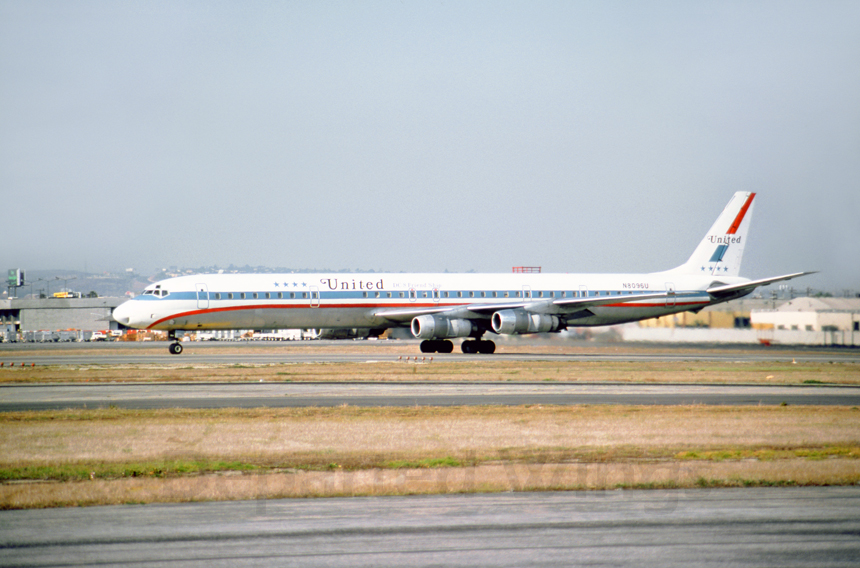
|
September
1976* Realizing an opportunity for growth of a successful airframe, Douglas made a decision in 1962, to extend the fuselage of the Douglas DC-8 both forward and aft of the wing to create the world's longest passenger airline at the time. The new variant was known as the Douglas DC-8 "Super 61," and entered service with it's launch customer United Air Lines on February 24, 1967. Initial routes were between California and Hawaii, which was the followed by transcontinental services. By 1976, the -61s were being used on service between Los Angeles and Denver, Newark, San Francisco, and Washington-Dulles. Seen rolling for takeoff on Runway 25 Left is N8096U, a Douglas DC-8-61. |
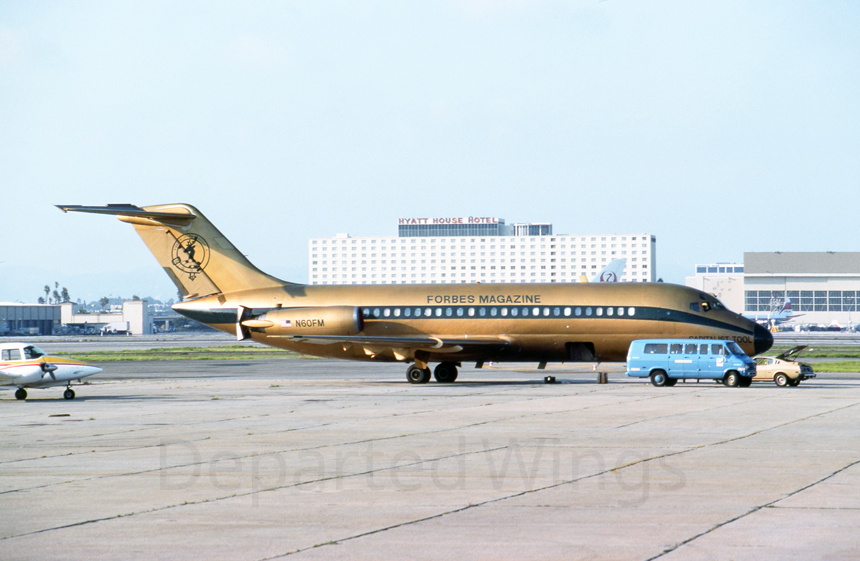
|
October
1976* In its early years, the Douglas DC-9 found popularity for use as an executive jet, including one delivered by the Douglas manufacturer to Forbes Magazine in October 1973. Named "Capitalist Tool," the gold painted DC-9 was used by Forbes publisher Malcom Forbes for business travel. The unique DC-9 remained in Forbes use until being replaced with a Boeing 727 in 1983. Seen parked on the general aviation ramp during a visit to Los Angeles is N60FM, a Douglas DC-9-15. |

| November 1976 By 1976, United Airlines had become the largest operator out of Los Angeles and was serving twenty-seven cities Nation-wide from the airport. The airline found the Boeing 727 a popular and logical choice on its short and medium ranged flights and no less than eighteen cities were being served from Los Angeles using the "Tri-Jet." Regional cities such as Bakersfield and Monterey, California to as far east as Birmingham, Alabama and Memphis, Tennessee were flown with the Boeing 727. Taxiing away from Terminal 7 for another flight and wearing the "Stars-and-Bars" color scheme is N7418U, a Boeing 727-22C, delivered new to United Airlines in March 1967. |
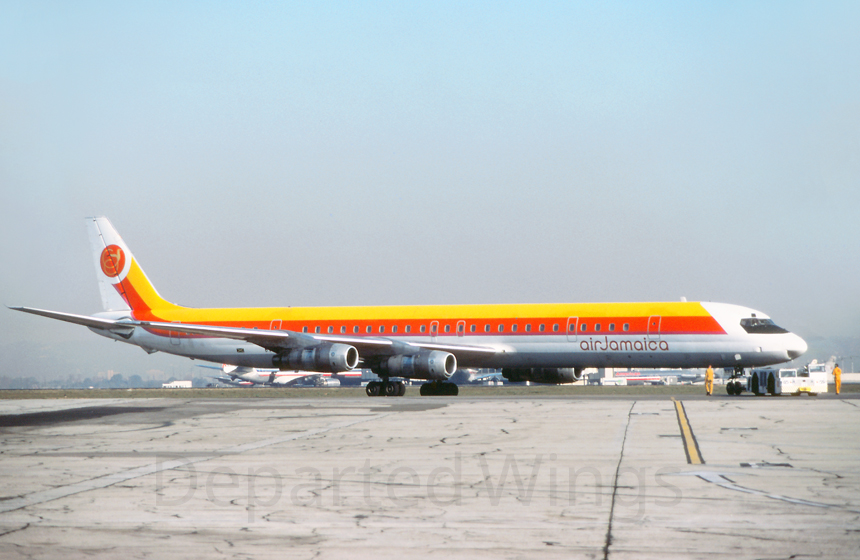
|
September
1976* During the 1970s, many airlines world-wide transitioned through Los Angeles on various passenger charter or tour group flights. One unique visitor was Air Jamaica which was providing vacation package charters to the Caribbean island state of Jamaica. Seen being pushed back from the ramp at the Imperial Terminal for mid-day departure to Montego Bay is 6Y-JGG, a Douglas DC-8-61, purchased by the airline from Eastern Air Lines in November 1973. |

|
September
1976* The national airline of Germany, Lufthansa started service into Los Angeles in 1968, its fifth city to add to its schedule in the United States. Early service was to Frankfurt via Paris using a Boeing 707 "Intercontinental Jet" on the three weekly flights providing a convenient connection to Germany from the U.S. West Coast. At the time the Lufthansa 707s had a seating capacity of 148-passengers in a two-class configuration with 16 first class and 132 economy seats. Seen rolling for takeoff on Runway 25 Right during a morning departure is D-ABOF "Munchen," a Boeing 707-430, delivered new to the airline on October 1, 1960. |
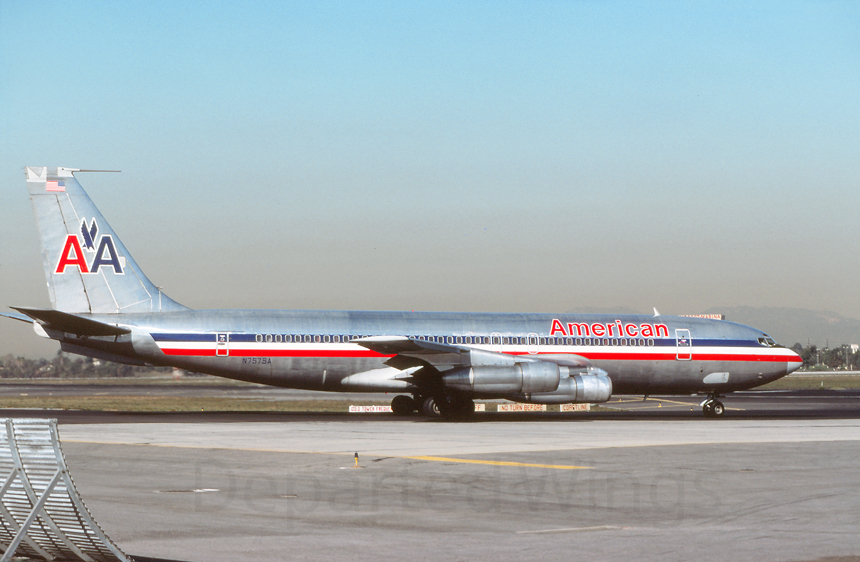
|
September
1976* American Airlines continued to use their eighty strong fleet of Boeing 707s, both the -100 and -300 series, throughout the decade of the 1970s. By 1976, Los Angeles saw the planes being used on no less then thirteen destinations from the airport including Cleveland, Newark, Philadelphia, San Diego, and Toronto, Canada. Seen holding short of Runway 24 Left for a morning departure is N7575A, a Boeing 707-123B, delivered new to the airline on January 5, 1967. |
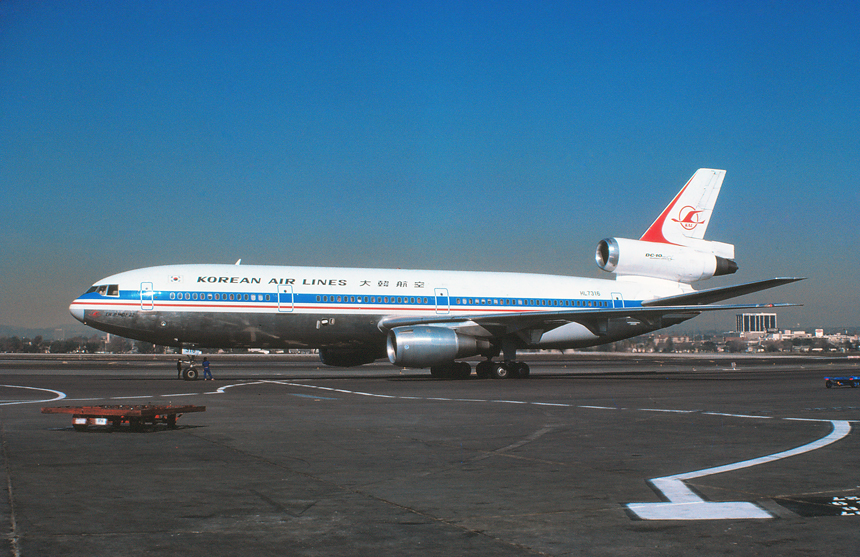
|
January 1977 The national airline of South Korea; Korean Air Lines, started trans-Pacific passenger services into Los Angeles in April 1972, using Boeing 707 aircraft on the twice-weekly service. The airline ordered five Douglas DC-10 for higher capacity, long-haul services with the first being delivered in 1975. The new Tri-Jet was placed on the popular Seoul-Tokyo-Honolulu-Los Angeles trans-Pacific services increasing passenger capacity on the route. The DC-10s only saw a few years of service to Los Angeles as they were soon replaced with the Boeing 747. Having just been pushed back from Terminal 2 for an afternoon departure is HL7316, a Douglas DC-10-30 and the first example delivered new to the airline in February 1975. |
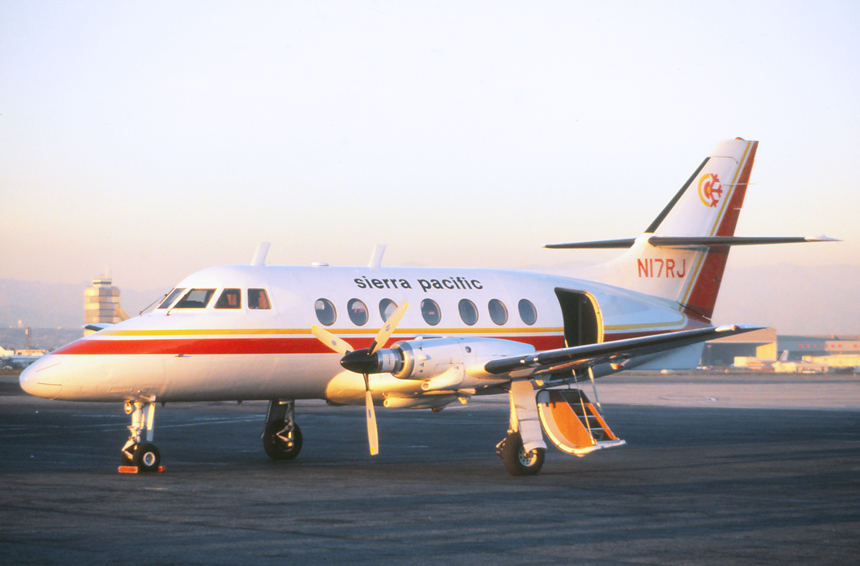
| February
1977 One of the many commuters established to cater to the recreational tourist market of the Sierra Nevada Mountains was Sierra Pacific Airlines. Originally started as Trans-Sierra Airlines, the airline focused on flights to the mountain resort community of Mammoth Lakes, located in the eastern Sierra Nevada Mountains. Scheduled passenger services to Mammoth from Burbank, Fresno, and Los Angeles started in 1975, using both a Convair 580 and small fleet of "new" Handley-Page Jetstream turboprops. The "commuter" service was quite popular especially during the winter ski season with the flights cutting traditional driving times down to an hour from the usual six hour drive. Parked at the Imperial Terminal and awaiting passengers for an evening departure is N17RJ, a Handley-Page HP.137 Jetstream, delivered new to Sierra Pacific in April 1976. |
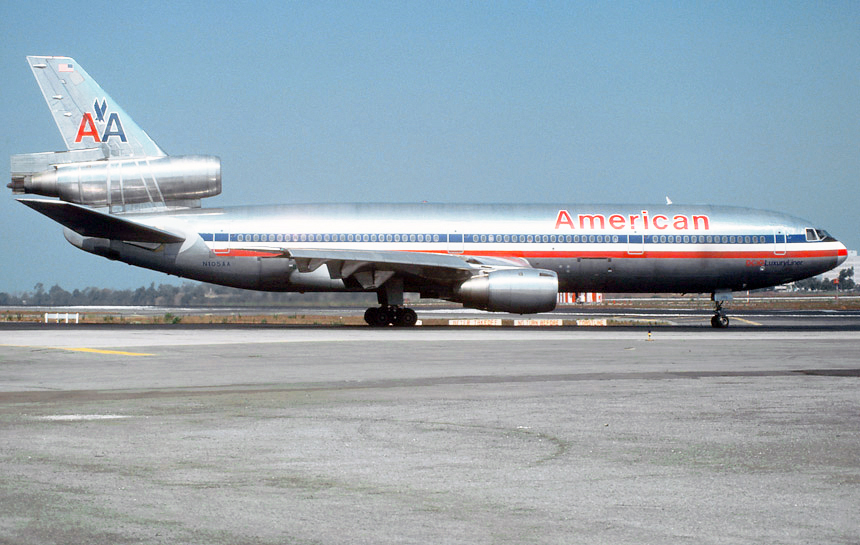
|
August 1977 American Airlines was the launch customer for the Douglas DC-10 and placed an order for twenty-five of the type with an option for an additional twenty-five more. American choose the new tri-jet for both medium domestic and long range international flights with a capacity for 250 passengers. American inaugurated service with the Douglas DC-10 on July 29, 1971, on a flight from Los Angeles to Chicago. From Los Angeles the DC-10 was soon placed on heavy trunk routes to Boston, Chicago, Dallas, Detroit, New York-JFK, and Washington Dulles. Holding short of Runway 24 Left is N105AA, a Douglas DC-10-10. |
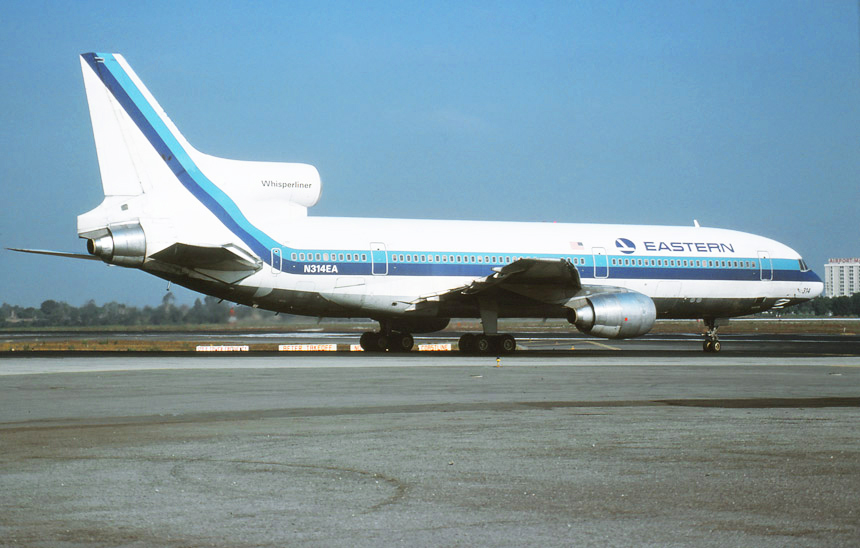
| August
1977 Eastern Air Lines was the second launch customer for the Lockheed L-1011 and ordered fifty of the aircraft. The first plane was delivered on April 6, 1972, and service was started a few weeks later between Miami and New York City with a stop in Atlanta. The L-1011s were used on high-density domestic and transcontinental services with Los Angeles receiving the Tristar in 1976, on non-stop flights to Atlanta. Approaching the active Runway 24 Left for a morning flight to Atlanta is N314EA, a Lockheed L-1011-385-1 Tristar 1, "Whisperliner." |
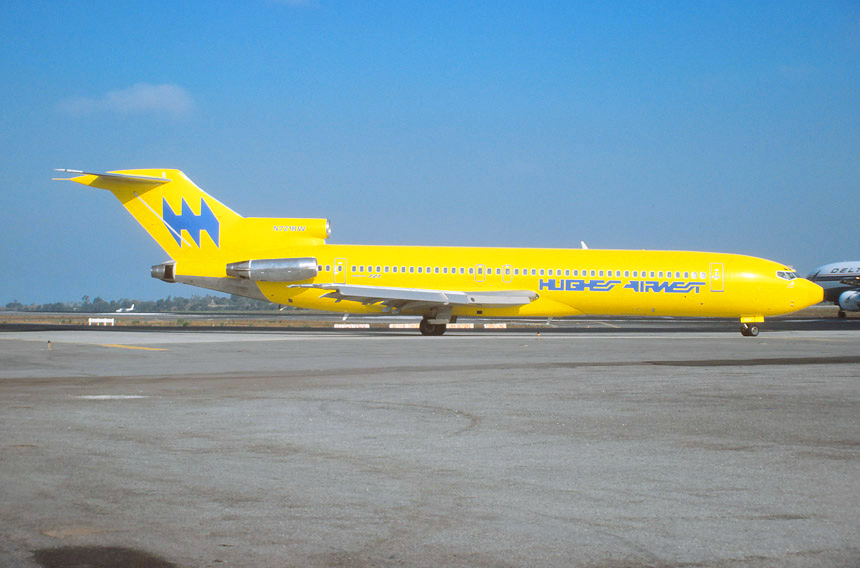
| August
1977 A year after Howard Hughes purchased Airwest Airlines in 1970, a Douglas DC-9 was involved in a mid-air collision with a Douglas F-4B Phantom over Duarte, California (east of Los Angeles). It was considered that one of the contributing factors to the crash was the all-white fuselage of the existing Airwest color scheme. The company which was hired to re-brand the new Hughes Airwest, Mario Armond Zamparelli, designed a bold and eye-catching livery that became famous throughout the 1970s (and was hoped to prevent another mid-air disaster). The entire fuselage of the planes were bathed in "Sundance Yellow" while airline script and tail design were in "Universal Blue." The newly painted aircraft were quickly dubbed the "Flying Bananas," and Hughes Airwest used this to their advantage in advertising and promotions until the airline was purchased by Republic Airlines in 1980. Waiting at the hold short point for a departing heavy Delta Airlines L-1011 is N721RW, "Spirit of Gamma," a Boeing 727-2M7. |
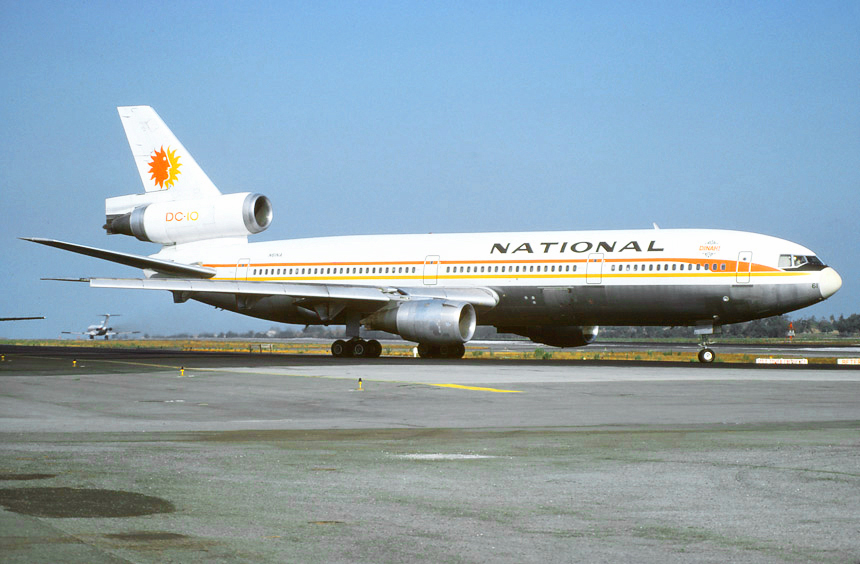
| August
1977 National Airlines ordered nine Douglas DC-10 aircraft in 1969, with a capacity of 256-passengers. The new-wide body Douglas tri-jets would be used to phase out the Douglas DC-8 and provide both transcontinental and high-density flights along the popular New York-Florida corridor. National's first DC-10 was delivered on November 1, 1971, and placed into service six weeks later on the winter "Snow-Bird," New York-West Palm Beach, Florida run. On February 1, 1972, the DC-10 was placed on the lucrative Los Angeles-Miami route and was eventually placed on services from Los Angeles to both Houston and New Orleans. Taxiing up to the Runway 24 Left hold short line for a morning departure is N61NA "Dinah," a Douglas DC-10-10. |
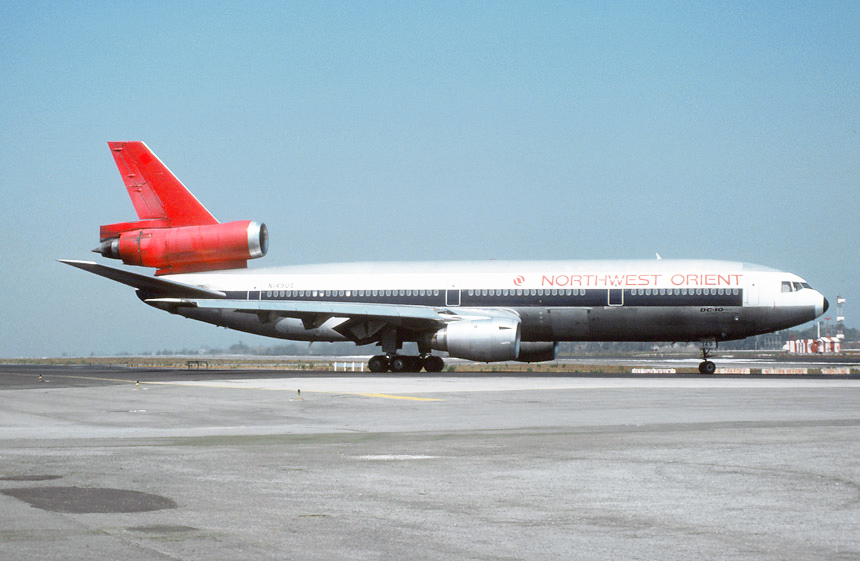
| August 1977 Northwest Orient Airlines was the launch customer for the "intercontinental" version of Douglas DC-10 series 40, which had a range of 5,800 miles. Northwest originally ordered eight of the aircraft, the first being delivered in November 1972, with additional deliveries over the next two years. The airline eventually operated twenty-one of the series 40 on both heavy domestic and international flights. The planes were to be used on trans-Pacific routings between city pairs that were not economically viable with the Boeing 747. During 1976, the 342-passenger Douglas DC-10 was placed on flights from Los Angeles to Minneapolis-St. Paul and Seattle. Taxiing up to the hold short point for Runway 24 Left on a hazy morning is N149US, a Douglas DC-10-40. |
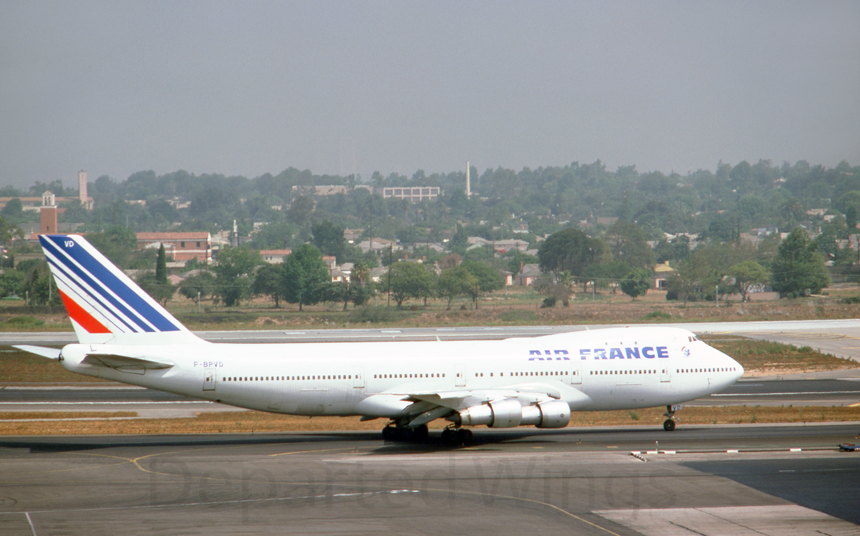
|
August 1977* Air France started service into Los Angeles in 1960 as a stop on their "Round-the-World" service between Papeete, French Polynesia and Montreal, Canada using a Boeing 707. Non-stop service was started between Los Angeles and Paris in 1964 using a Boeing 707. Boeing 747 flights were started in the 1972, initially twice-a-week on the Los Angeles-Montreal-Paris Orly route while the Boeing 707 provided non-stop Paris service. By 1977, Air France was using the Boeing 747 solely on non-stop Los Angeles-Paris Charles de Gaulle services three times weekly. Seen taxiing outbound toward Runway 25 Left for a late afternoon departure is F-BPVD, a Boeing 747-128 delivered new to Air France on July 14, 1970. |
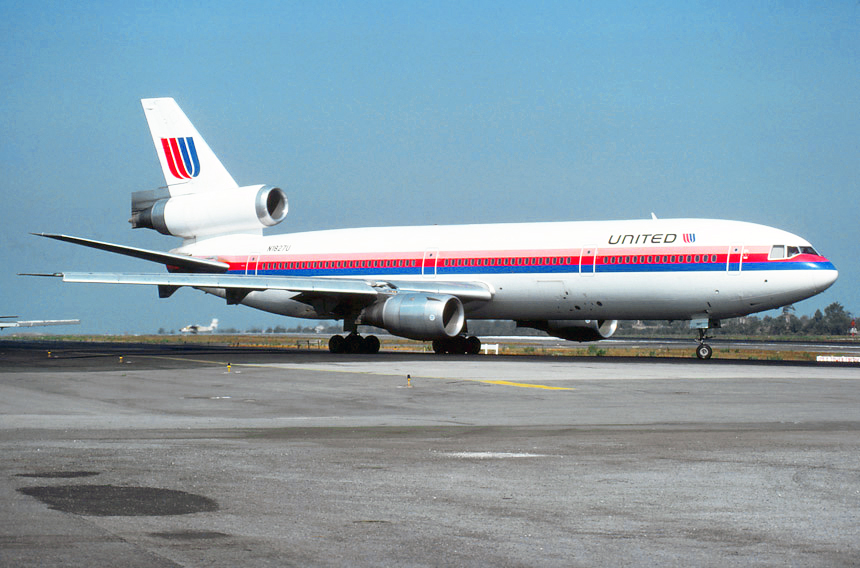
| August 1977 United Airlines sought an aircraft that could provide transcontinental routings and "fit" between the large capacity Boing 747 and the smaller sized Douglas DC-8. After being courted by both Lockheed and Douglas, United choose the DC-10 prototype and ordered thirty of the aircraft in 1968. The first Douglas DC-10 was delivered to United Airlines in July 1971 and placed in service between San Francisco and Washington Dulles a few weeks later. The new DC-10 was soon placed on services from Los Angeles to Chicago, New York-JFK and Washington Dulles. Taxiing up toward Runway 24 Left for a mid-morning departure is N1827U, a Douglas DC-10-10, delivered new to United Airlines on April 25, 1975. |

|
August 1977 During 1973, United Airlines embarked on a brand redesign and hired legendry graphic designer Saul Bass to lead the effort. His result was the infamous United "Tulip" which defined movement, winged flight, and the American Flag all in one logo. A new tri-color stripe would adorn the fuselage and replace the familiar light blue that had brought United into the jet-age. Over the next few years the arduous process of painting new and existing aircraft took place and the famous United logo, become one of the most recognized for the next twenty years. By 1977, United Airlines was operating eighteen of the Boeing 747 and the plane became a common sight at Los Angeles as it was used on daily flights to Chicago, Honolulu, Hilo, and New York-JFK. Holding short of Runway 24 Left and waiting for departing Lockheed L-1011 traffic is N4723U "William A Patterson," a Boeing 747-122, named after the United Airlines president between 1934 and 1966. |

| August
1977 By the late 1970s the Boeing 707 was starting to show its age a bit after some fifteen years in service and with competition from newer airframes. In 1977, Trans World Airlines (TWA) was still using its famed "Fan Jet" on services from Los Angeles to Chicago, Kansas City, St Louis, and Washington Dulles. Taxiing up to Runway 24 Left for a morning departure is N758TW, a Boeing 707-131B, delivered new to TWA on August 21, 1962. |

| August 1977 As more Douglas DC-10s were delivered, the airline marketed the DC-10 as a "Spaceship" due to the "wide-body" comfort and spacious seating the new planes would provide. The DC-10s continued to be placed on longer range or popular routes such as the Los Angeles-Mexico City "Fiesta" service and the Los Angeles-Honolulu "Islander" flights. Awaiting takeoff clearance and wearing the simple yet elegant "Swizzle-Stick" color scheme is N902WA, a Douglas DC-10-10, the second aircraft to be delivered to the airline on June 12, 1973. |
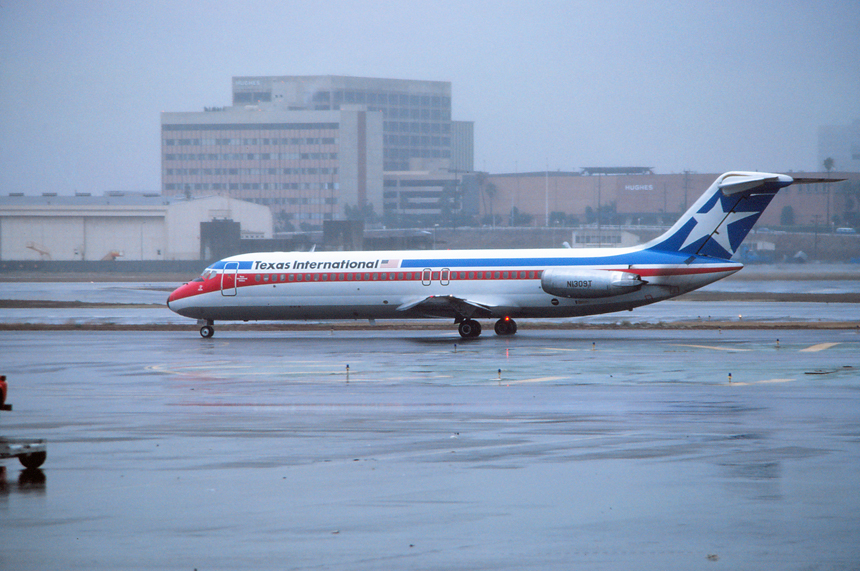
| August 1977 Regional airline Texas International started operations in 1947 as Trans-Texas Airways. During the 1960s, the airline added the Douglas DC-9, its first "jet" aircraft and inaugurated service to Monterey, Mexico prompting a name change to Texas International. In 1970, the airline received approval to start service to Los Angeles from Dallas-Ft. Worth via Albuquerque, New Mexico. This was a significant step for the carrier as it was now competing with the "Big Boys" of Delta Airlines and American Airlines into Dallas, however the airline prevailed and continued its one-stop service into the 1980s. Taxiing outbound for takeoff during a rather rare summer rainstorm is N1309T "City of Austin," a Douglas DC-9-31, originally delivered new to Texas International in January 1969. |
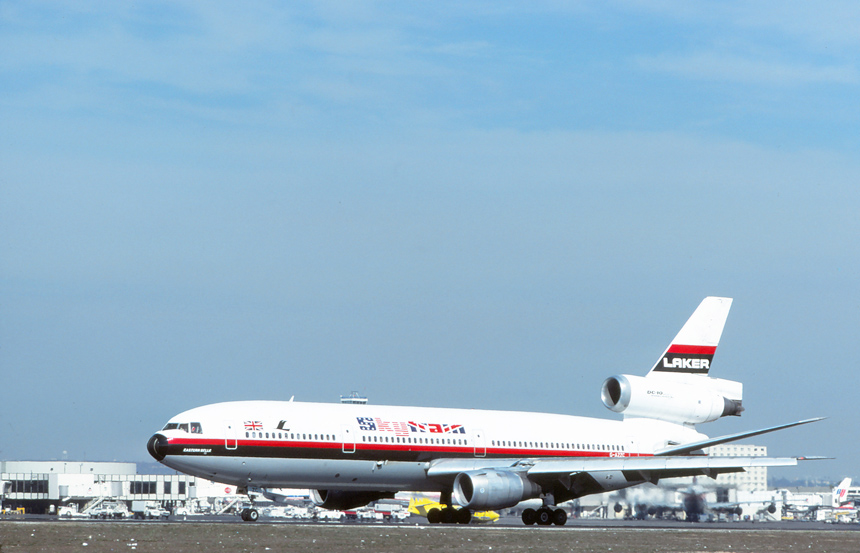
| November 1977 Formed in 1966, by the aviation entrepreneur, Sir Freddie Laker, Laker Airways was a British charter airline based at London Gatwick Airport. With sights set on North America, Freddie Laker embarked on a series of battles to establish a low cost, "no frills" operation between the England and the United States. The airline acquired the Douglas DC-10 after a careful study of operating economics and soon introduced deeply discounted "Skytrain" services. Initial services were started between New York-London in September 1977, however services into Los Angeles had started in April 1977 to Manchester, England with a technical stop at Niagara, New York. Within a year, Laker was providing daily London Gatwick-Los Angeles service that remained popular until February 1982, when the airline filed for bankruptcy. Rolling out on Runway 25 Left after a trans-Atlantic flight via New York-JFK is G-AZZC "Eastern Belle," a Douglas DC-10-10. |
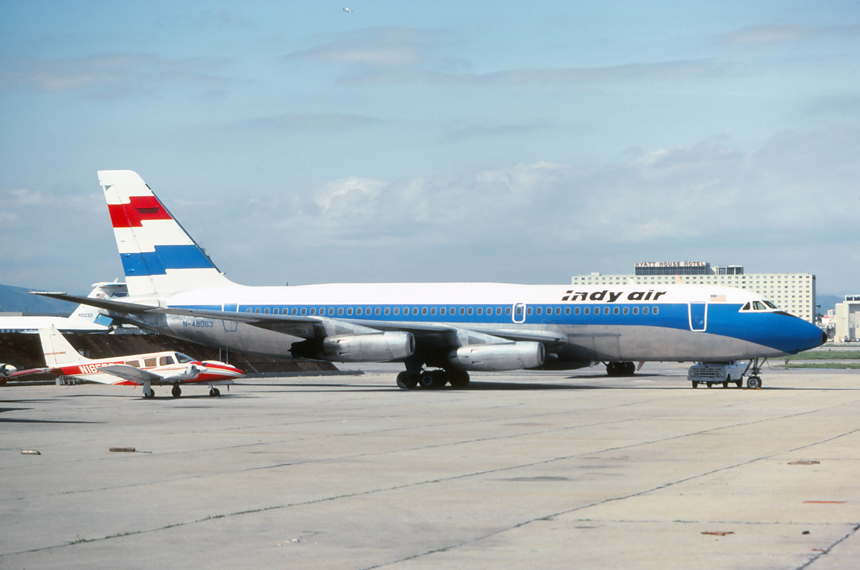
| March
1978 During the 1970s numerous member based groups formed their own aircraft based "tour" airlines to cater to their membership. The cost of operating and maintaining an aircraft was typically very expensive and many of the groups would lease out the aircraft for various military or public charters. Indy Air, based in Indianapolis, Indiana was one such member based flying club which purchased a Convair 880 to fly members to various destinations in North America and Europe. As with many of the "clubs," aircraft operation become too taxing financially and the planes were sold off or in the extreme cases the club went bankrupt. Indy Air was only in operation for about a year before being dissolved. Parked and secured at the south general aviation ramp during a charter flight is N48063, a Convair 880M (22M-21) |

| March
1978 Trans International was one of the largest supplemental carriers in the United States having been established as Los Angeles Air Service in 1948. Over the next thirty-years, Trans International grew with the operation of military charter flights being conducted world-wide. The airline also provided both passenger and cargo charters and most of the aircraft operated were able to be converted for either service. In 1976, Trans International purchased charter operator Saturn Airways and added even more charters, contracts and aircraft to its already extensive portfolio. To add more capacity and range, the airline ordered three convertible capable Douglas DC-10s with the first being delivered in 1973. Parked at the Imperial Terminal and being loaded for a charter flight is N102TV, a Douglas DC-10-30CF, delivered new to the Trans International on June 4, 1973. |

|
April 1978 Merpati Nusantara was the second largest regional airline in Indonesia and was established by the government in 1962, to fly domestic services. The airline remained domestic flying to hundreds of destinations within the extensive island chain of Indonesia until 1976, when a Boeing 707 was leased for international charter work. Initial charters were to Japan and Hong Kong before permission was granted for trans-Pacific services in 1977. In an effort to boost tourism weekly charter flights were started between Bali (Denpasar) and Los Angeles via Honolulu with the 707. The charters lasted until only until 1979, when low passenger numbers and escalated costs forced the airline to cancel charters. Parked at the Imperial Terminal during a charter flight is N107BN "Princess of Bali," a Boeing 707-138B, originally delivered to QANTAS airlines in 1964, and leased by Merpati Nusantara in July 1976. |
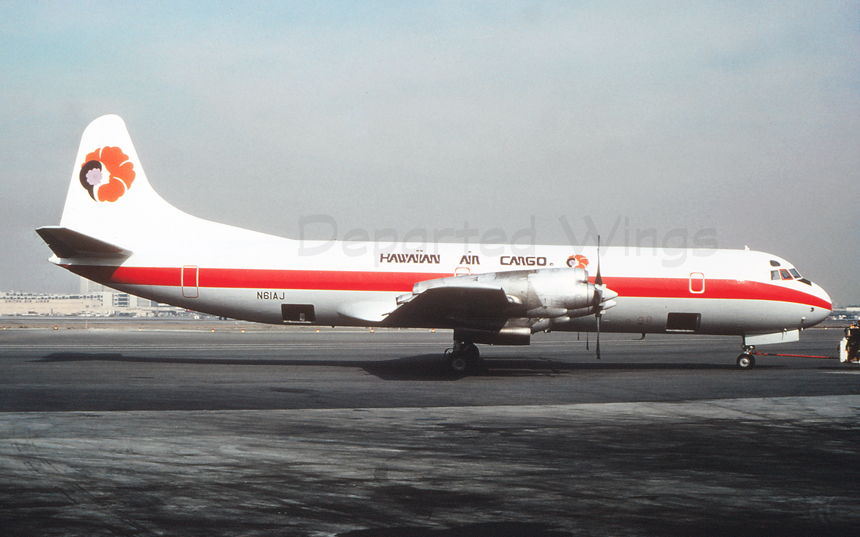
|
November 1978 In the post cargo airline deregulation era, many airline sought to establish an air cargo niche to expand services or focus on specific freight. One unique entrant into the air cargo market was Hawaiian Airlines which leased eight Lockheed L-188 Electra Freighters in 1978 for cargo service within the United States. Painted in the familiar Hawaiian Airlines colors, the Electra's were seen on cargo ramps throughout the U.S. on both contract and charter air freight services. Although an interesting concept, Hawaiian found the venture economically taxing and with competition from other air fright companies shut down its air cargo specific business in 1980. Seen parked on the south cargo ramp is N61AJ, a Lockheed L-188-A(F) Electra. |
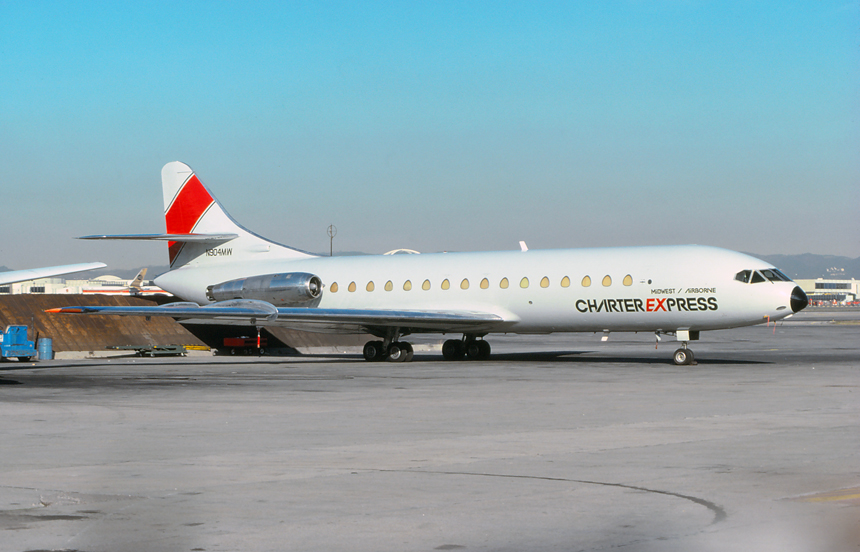
| December 1978 Airborne Freight Corporation was started in 1968 as a regional air freight forwarder based in Seattle and using leased space on other carriers to operate. One of the larger carriers that Airborne leased was Midwest Air Charter based in Ohio. After the deregulation of the air cargo industry in 1978, Airborne Freight merged with Charter Express to become Airborne Express. Midwest Air charter had purchased six of the French built Sud Caravelle and converted them for all cargo service. The Caravelle was used on busier city routes, with Los Angeles being a major freight market. Parked at the south cargo ramp and wearing the initial Airborne colors is N904MW, a Sud SE-210 Caravelle VI-R. |
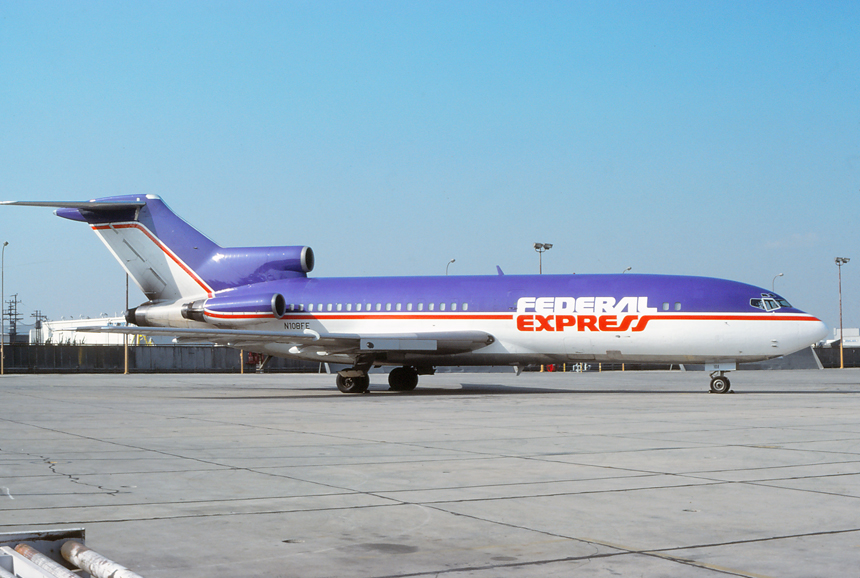
| January 1979 Federal Express was started as an air freight company dedicated to time-sensitive shipments. In April 1973, the airline set out to conquer the overnight package market using a fleet of fourteen Dassault Falcon jets flying to twenty-five cities in the U.S. As Federal Express set a precedent for service and on-time shipping, the airline continued to grow considerably and with the deregulation of the air cargo industry in 1977, Boeing 727 and 737 aircraft were acquired for the growth. Los Angeles was the first airport to host the Boeing 727 when flights were started to its Memphis hub on January 30, 1978. Parked at the cargo ramp in the characteristic purple and crimson color scheme is N108FE "Rebecca Gail," a Boeing 727-22C, originally delivered to United Airlines in 1967, and purchased and converted to freighter by Federal Express in September 1978. |
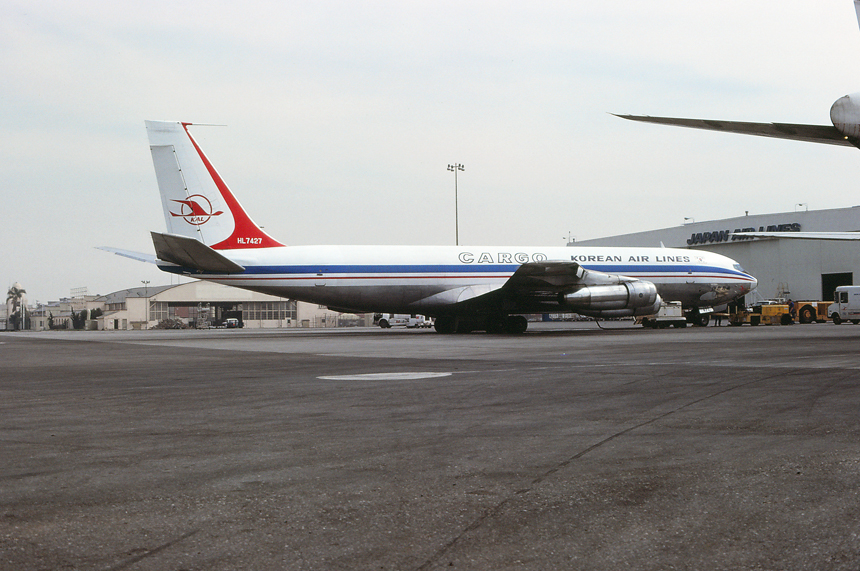
|
February 1979 Korean Air Lines founded the all-cargo division of the airline in 1971, and cargo flights started on a Seoul-Tokyo-Los Angeles routing using a Boeing 707. Cargo specific flights were so popular that the volume justified the introduction of the Boeing 747 Freighter on the trans-Pacific service in 1973. Both the 707 and 747 freighters would provide almost daily service into Los Angeles so much so, that Korean Air Lines Cargo opened their own dedicated cargo terminal at the airport in 1981. Parked at the south cargo ramp and waiting another load of cargo is HL7427, a Boeing 707-321C, originally delivered to Pan American Airlines in 1967, and leased by Korean Air Lines in February 1977. |

| February 1979 Taking advantage of the deregulation of the air cargo industry in 1978, Emery sought to maintain its title as one of the world's largest freight forwarders by adding its own "air force" of aircraft to provide centralized air cargo service. In September 1976, Emery added fourteen aircraft to its fleet by leasing planes including the Douglas DC-8, Lockheed Electra, Convair 580 and various smaller piston engined types. Due to the freight volume, Los Angeles soon hosted the Douglas DC-8, which had a capacity of over 30 tons on its daily visits to the airport. Parked on the south cargo ramp during a rainy winter afternoon is N8245U "Town of Wilton," a Douglas DC-8-33, on lease to Emery and being operated by Evergreen International. |
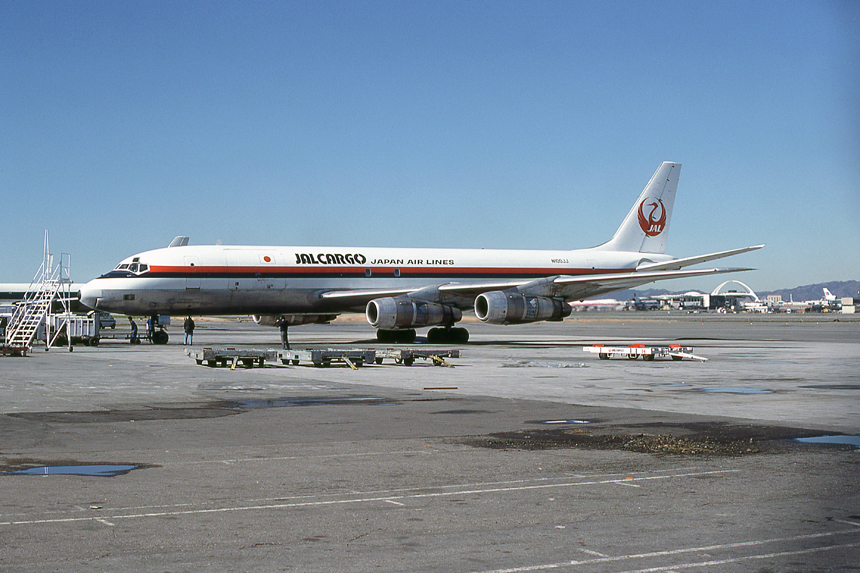
| February 1979 One of the few airlines that has it's own all cargo division, Japan Airlines (JAL) started an cargo subsidiary of the airline in 1959. Early flights connected Japan to San Francisco using a converted Douglas DC-6. In an effort to increase range and capacity JAL placed into service the Douglas DC-8 "Jet Trader" which was the all-cargo version of the manufactures best selling DC-8 series. The new freighters could carry up to forty tons of freight and were placed into service in October 1967, on a Tokyo-San Francisco-New York route. Los Angeles received JAL's DC-8 freighters in the early 1970s providing a quicker route of goods transport between Southern California and Japan. Parked at the south cargo ramp during a winter layover is N100JJ, a Douglas DC-8-55, originally delivered to JAL in November 1965 as the passenger version and then converted to a freighter in 1977. |

|
June 1979 As one of the major trunk carriers in the United States, Delta Airlines had aspirations to extend services to the West Coast, however the Civil Aeronautics Board (CAB) gave route authority to American Airlines. Delta did provide service west via interchange route agreements, with other airlines aircraft and crews. In 1961, Delta was finally granted authority to start routes to the West Coast from both Atlanta, New Orleans, and Dallas. Flights into Los Angeles started on June 11, 1961 and when Delta introduced the Douglas DC-8 "stretch" series-61 in 1967, the were immediately placed on the popular transcontinental services. Taxiing up to the hold short point for Runway 25 Right for an evening departure is N1300L, a Douglas DC-8-61, delivered new to Delta Airlines in August 1968. |

|
June 1979 United Airlines fleet of 158 Boeing 727s, provided both short and medium range services from Los Angeles with no less then fifty daily flights to nineteen cities nationwide including Des Moines, Kansas City, Omaha, Santa Barbara, and Spokane. Taxiing toward Runway 26 Left for an early evening departure is N7268U, a Boeing 727-222 Advanced, delivered new to United Airlines, a year earlier on June 20, 1978. |
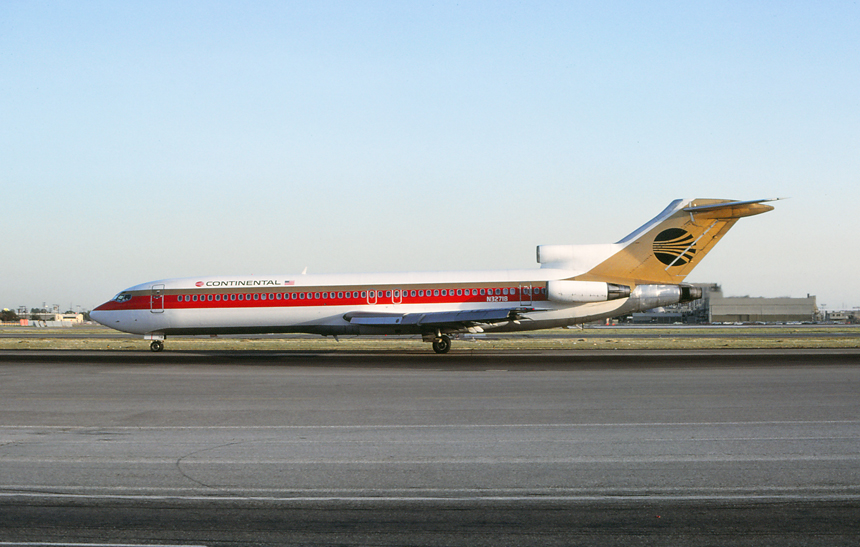
|
June 1979 Having consolidated its fleet down to just the Douglas DC-10 for long-haul service and Boeing 727s for short and medium range routes, Continental Airlines had fifty-two 727s in operation by 1979. From Los Angeles, the main routes using the 727 were to El Paso, Phoenix, Ontario, Tucson, and San Antonio. Awaiting takeoff clearance on a warm summer evening is N32718, a Boeing 727-224, delivered new to Continental Airlines on April 8, 1970. |

|
June 1979 Mexico's flagship airline Mexicana had settled on the versatility and compatibility of the Boeing 727, and during the 1970s was using the aircraft as its sole choice in its fleet of twenty-five. By 1979, Mexicana was flying daily service from Los Angeles to Guadalajara, Mexico City, Puerto Vallarta, and Mazatlan. Taxiing out to Runway 26 Left for an early evening departure is XA-CUN "Oaxaca" a Boeing 727-264. |
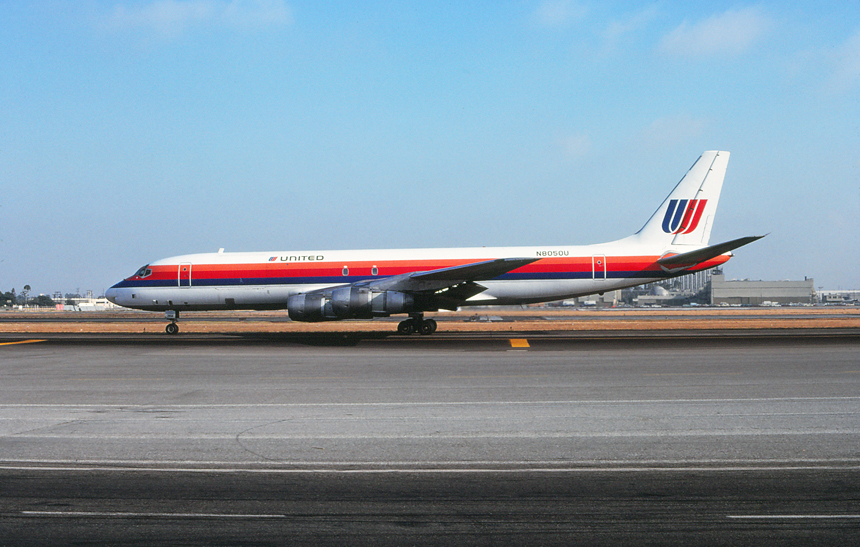
|
July 1979 During the 1940s, many of the major carriers established their own cargo or freight division of the parent airline. Initially using converted Douglas DC-8s for "Jet Freighter" service, United eventually ordered the "Freighter" specific version of the DC-8 for cargo only flights. From Los Angeles the cargo DC-8s were flown to San Francisco, Cleveland, and Chicago. Taxiing toward Runway 26 Left for an evening departure is N8050U, a Douglas DC-8-54AF, delivered new to the airlines in March 1968. |

|
August 1979 American Airlines took delivery of its first Boeing 727 in April 1964, and eventually became the largest operator of the type world-wide with a fleet of 182 aircraft at peak. The 727 was well suited for American's short and medium haul network and was seen on routes in the late 1970s from Los Angeles to Chicago, Dallas-Ft. Worth, El Paso, Memphis, and Nashville. Taxiing up to Runway 26 Left for a morning departure is N1957, a Boeing 727-35 delivered new to American Airlines in November 1967. |
Continue with Los Angeles-LAX 1980s
Back to: Los Angeles-Index or The Airports